Food yes. China, certainly. This time; cats, maybe not so much. But the death of the United States? Ah. The stench is everywhere.
Oh, yes. And DETROIT style pizza. Yum!
What features do you miss from older homes that are not included in newer homes?
I have lived in a number of older homes over the decades. There are so many features that used to be common, that I miss. Both in the Northern and Southern US.
Pocket Doors. These were popular at one point and they were super useful. They were doors that would slide into the wall and disappear. They have sort of made a comeback, but they aren’t as common as they once were and they are so nice. No hinges/door clearance to worry about. Easy enough to be left cracked without fear of slamming shut in a breeze.

Louvered windows and doors. In the south, on older homes, these are common. Not so much in other areas or some modern construction. These allow you to have open windows and yet if it rains, makes it less likely that the rain will come in if you forget to close them before a rain shower/storm. Plus, on doors, if you have pets, it helps keep the pet from busting out the screen and escaping, and reduces the need for a screen/storm door.

Cast iron hot water radiators. These were always amazeballs. You could adjust the heat per room, you could put a bowl of water on them to humidify a room, you could put your winter gear by them to warm before going out in the cold/dry out after being outside, use as a towel warmer in the bathroom. If you got/had the cap for them you could also use them to keep your coffee/tea warm by setting the cup on top.
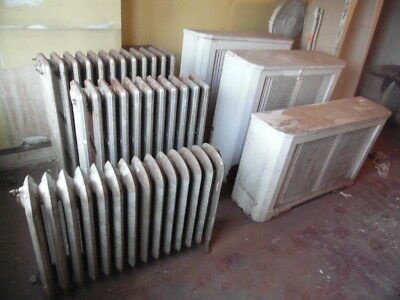
When they worked, they worked really well. The problem is that the water in the radiators was never filtered, and the heat caused a buildup of sludge inside the pipes. This, in turn, resulted in all sorts of problems. Today, you can use automotive radiator fluid to prevent that build up. And the heat distribution would be much improved. -MM
Clawfoot/deep bathtubs. I love a good bubble bath, or a long hot soak after a physically active day. Modern bathtubs are kind of a joke, I have to choose which body part gets to be submerged, since modern ones are too shallow and short to actually soak in. The old-fashioned claw foots would allow you to actually soak, and you could soak sore legs and back at the same time, if you were under 6 ft tall you could also stretch out a bit.

The 1960s - 1970s "modern" tubs are designed for appearance. And not for use. No wonder that everyone started to shower back then. Now the McMansion's are equipped with whirlpools and spa's that never get used. -MM
Direct to the outdoors kitchen exhaust fan. I loved one place I lived that had this over the stove. These bad boys sent cooking fumes, smoke, heat, directly outside. No filters to change, no fancy gadgets with it etc. Just turn on and bye-bye odors, heat, smoke, etc. Those modern hood exhaust fans are like the wimpy, half-assed distant cousin to these.

Actually, the current exhaust fans are under-powered if they lead to a duct. And if you use a duct, you MUST make it short and as straight as possible. I once lived in a house where the building contractor just had the duct ending inside a dry wall with no venting to the outside at all. -MM
The first home computers were REALLY basic.
My first computer was a Tandy TRS-80 Model 1, bought in 1978.
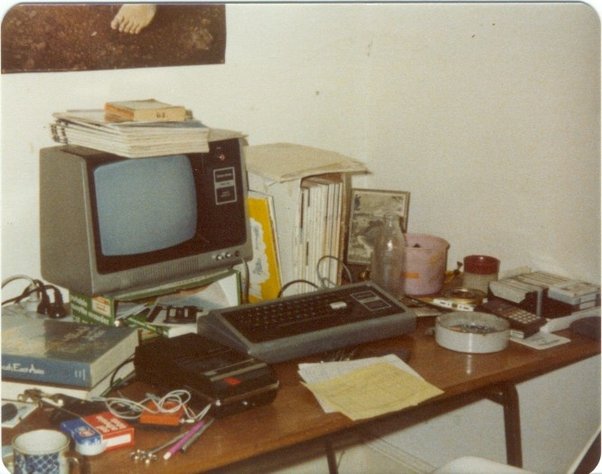
Please admire the sophisticated cardboard box monitor stand and the huge cassette data storage archive. The calculator was needed because the computer was rubbish at actually calculating things. And hey – I still have that mug 43 years later. The little orange box to the left of the cassette deck was an audio splitter so the deck’s output went to the computer and to headphones. This will be explained shortly in a dramatic twist related to data storage. Oooh. You’re so excited now.
- It had 4K RAM. Yes, 4,096 bytes, not megabytes. Which helps explain why programmers used 2-digit years dates and led to the Millennium Bug of 2000. Wasting 2 bytes of RAM to add “19” to a year was an extravagant waste of precious memory. I wrote myself a text editor (in Z80 machine code), but it consumed about a half of my RAM, so my text documents could only be REALLY small.
- The screen display was 25 x 80 characters. All UPPERCASE (because having lowercase was another extravagant luxury). And it was monochrome, naturally.
- Hard disk drive? ROFL. Easier to buy a unicorn. Floppy disk drive? I would’ve had to sell a house to buy a FDD back then. We had cassettes to store our data and programs on. Like real men. If you wanted to store more than one file on a cassette, you had to fast-forward and listen for where one hiss ended and the next began. All cassettes were adorned with hand-written sticky labels listing the tape-counter values of each of the programs stored on the tape.
- The operating system was in ROM and could never be updated. And the OS was Microsoft BASIC.
- It goes without saying that it didn’t do multitasking. It was barely able to singletask.
- It didn’t have a fancy battery-backed real-time clock. Every time it was turned on, I had to enter the date and time manually. So, nearly every document had the same 1 January date (because I couldn’t be bothered setting the clock every day).
- Commercial programs were as rare as hen’s teeth, and of course there was no internet. If you wanted a program, you wrote it yourself (and couldn’t share it, even if you could find another citizen in your state who had any computer at all).
Those were the days.
Yvonne Elliman – If I Can’t Have You
Time machine…
How can China build infrastructure so quickly? How come it’s so fast compared to Canada or the USA?
There are three basic reasons:
- China’s government is laser-focussed on infrastructure development; it’s a top priority. For the Canadian and US governments, it’s not.
- China’s government, by virtue of its authority, can clear away all hurdles that get in the way of infrastructure construction. The Canadian and US governments cannot.
- The Chinese companies that do the infrastructure construction have innovated the engineering necessary to get the job done efficiently. They’ve had many decades of experience.
These are all in addition to the fact that the Chinese are highly disciplined, hardworking, and intelligent. It’s a cultural thing.
Europe’s ‘patronising’ efforts to counter Russia and China in Africa falling flat
Europe’s ‘patronising’ efforts to counter Russia and China in Africa falling flat
EU leaders’ ‘lack of effort’ at winning over their African counterparts have left a ‘bitter taste’, according to Senegal’s President Macky Sall
Europe has pledged hundreds of billions of dollars under the Global Gateway Initiative, designed to counter China’s Belt and Road Initiative
Monday, 12 September 2022, 12:00:PM
Western nations may have come up with various initiatives to counter growing Chinese and Russian influence in Africa, but African leaders have been “disappointed” by the way they go about it.
This was evident at the African Adaptation Summit in Rotterdam last week when European leaders failed to turn up for a meeting to fundraise for Africa’s climate adaptation projects.
Dutch Prime Minister Mark Rutte, the only European leader to attend in person, said: “I would have loved to have more of my European colleagues here.”Six African heads of state were present, including the current African Union chairman and Senegal’s President Macky Sall, as well as leaders from Ghana, Gabon, the Democratic Republic of Congo and Ethiopia.
Sall said: “I cannot help but note, with some bitterness, the absence of leaders from the industrial world. I think if we made the effort to leave Africa to come to Rotterdam, it would be easier for the Europeans and others to be here.
“This leaves a bad taste in our mouths. I am a bit disappointed, to be honest.”
In another incident, at the EU-Africa Summit in Brussels in February, around 40 African leaders were invited by the European Union, but at one point only the Belgian Prime Minister Alexander de Croo was reportedly present from the other side.
“It was a very bad form on the part of the Europeans. They could have coordinated to have substantive representation throughout the event,” W. Gyude Moore, a former minister of public works in Liberia, said. “Could you imagine where Africans hosted 40 European leaders at an event in Accra and then left them in the room with the president of Ghana?”During that event, the EU announced that it would mobilise a financing package worth around US$150 billion for projects on the continent. The amount is half of what the bloc has allocated for the Global Gateway Initiative, which is touted as an alternative to China’s Belt and Road Initiative.
As part of the EU-Africa Summit, some deals were signed in Senegal, but progress has been overshadowed by the events in Ukraine and Covid-19. “There is a long history of unfulfilled commitments, so this might just be par for the course,” Moore said.Observers say the EU is nervous about the fact that it is losing influence in Africa with the growing presence of China, Russia, Türkiye and other global players. But the EU is internally divided and not able to live up to its ambitions to become a stronger global player, according to Geert Laporte, the director of European Think Tanks Group.
Laporte said the new “scramble for Africa” among global players was already going on. “With the war in Ukraine, interests in Africa have grown and the Africans have skilfully managed not to take positions so as to avoid becoming again drawn into a new cold war,” Laporte said.He said several African leaders and their populations had lost trust in Europe with “Europe patronising, overpromising and underdelivering”.
“To turn the tide, the EU is copying China and other global players with big funding promises (Global Gateway) mainly in visible infrastructure type of initiatives. But with the war at home it is not obvious that the EU will be able to keep its promises,” Laporte noted.The continent has recently witnessed a procession of high-profile visitors from France, the United States and Russia, but observers said America and Europe were known to make promises that they did not deliver.Adams Bodomo, a professor of African studies at the University of Vienna, said, “the US and EU have never hidden the fact that they want to counter China”.
Each of their master plans about Africa was always constructed as an alternative to the belt and road, Bodomo argued, but the EU and EU were more talk than action. “China plans and builds but the US plans and bombs,” he added.Bodomo said Russia’s inroads into Africa were designed to show that it was a viable alternative to Western powers in Africa, and to leverage its good relations with the continent with an eye on votes at the United Nations.
“And one thing I definitely dislike is being told ‘either you choose this or else’. When a minister speaks to me like that … I definitely will not be bullied in that way, nor would I expect any other African country worth its salt to agree to be treated [that way],” Pandor said.South Africa is among dozens of African countries that abstained from voting on the UN resolution condemning the Russian invasion of Ukraine.
Last month, Chinese Foreign Minister Wang Yi told a group of African leaders in a virtual event that “China is making steady progress in implementing all the pledges it made in Dakar [at the Forum on China–Africa Cooperation last year], despite various difficulties and disturbances”.He said over US$3 billion had been delivered out of the US$10 billion of credit facilities pledged to African financial institutions, and nearly US$2.5 billion of loans were channelled to Africa’s priority programmes. More than US$2 billion of the US$10 billion of trade finance had been allocated, Wang said.
France, which has in the past contributed thousands of troops to bring stability to fragile West African nations, is now being challenged by Russia. France’s last troops left Mali in August, ending a nine-year anti-terror operation after Bamako accused it of supporting terrorist groups. And they are being replaced by Russian mercenaries from the Kremlin-linked Wagner mercenary group.Moore said “the growth of both Chinese and Russian influence in Africa has heightened the pace at which their rivals and adversaries have visited the continent”.
Alex Vines, head of the Africa programme at London-based think tank Chatham House, said 25 per cent of the United Nations General Assembly was African – “the numbers game matters for many – increasingly in a world of multipolarity and increasing geopolitics”.Vines said the Russian invasion of Ukraine happened a week after the EU-Africa summit and EU attention was focused elsewhere, but added: “Increased EU funding through the Gateway Europe initiative is still planned.”
For Russia and China, “the simply large number of countries in sub-Saharan Africa makes it a less expensive place to ‘buy’ votes in international organisations”, according to Douglas Yates, a political scientist specialising in African politics at the American Graduate School in Paris.“Not only are these countries interested in the ideological struggles of international votes and sanctions and the like, but they make excellent grounds for espionage – because African countries often have information, and they are quite porous,” he said.
.
Keeping the peace
Quan is spot on on this: "there is not a single example of the warmongers having being stopped by reasonable petitions for peace in the history of humanity." Mao famously put it: 以退让求和 则和平亡 以斗争求和 则和平存 Meaning: Using Compromising to pleased for peace, peace will die Using all means and method to fight for peace, peace become possible. In Today China, under Xi, the experience dealing with the crusaders is: 能战方能止战 敢战方能言和 meaning: Only one with the capability to fight a war could stop a war Only one dare to fight a war can talk peace. The barbarian warmongering crusader civilisation will only end a war when they suffered ongoing defeat. Eg Vietnam war, Korean war, Afghanistan etc. The barbarian dare not touch the Russian after WW2 due to Russia Readiness to use nuclear weapons. Another Chinese leaders frequently used terms " 弱国无外交"(weak nations have no diplomacy) So, the foundation for peace facing a barbarian civilisation is to armed one self to the tooth and ready to fight a war if they dare to fire the first shot. I am fearful of Christianity because there is always a tendency of a religious crusader leader happy to see the end of the world to achieve the socalled eternal life when Jesus's return to earth. The west lack great thinkers, peace philosophers, and teachers like confucius, Sunzi, laozi, mengzi, shunzi, mozi,etc, who not only are great thinkers but great teacher themselves. So, till this day, the crusader DNA nations still believe that looting and bullying the weaker nations is their nature right. Putin the Great is right with his strategy to destroy the crusader economy using energy price between friendly and unfriendly countries to keep the peace. Cheers Chua
How do Italians eat so much olive oil?
This big boy on the photo below is estimated to have between 3000 to 4000 years of age, we call him “S’Ozzastru” in our Sardinian language, The wild Olive Tree! You can find similar plants all over the Mediterranean: Italy, Greece, Spain, Tunisia, Lebanon, Turkey and so on.
They’ve been living here before us, this is their home and we are just their guests.

Many many centuries ago, Mother Nature decided to bless my people in the Mediterranean Basin with a majestic plant. An incredible tree, that not only can withstand the impressive amounts of sun and drought of our climate, not only is able to live for thousands of years, but it can also give us arguably one of the best oils on the planet: the extra virgin olive oil.
Olive oil is a gift from nature, not by chance its color resembles gold. It was cheap to make, it provided lot of good calories, it’s super healthy and it tastes like nothing else. It goes well with almost any kind of ingredient from the Mediterranean, so well that we built our own cuisines around it.
Italian cuisine without olive oil wouldn’t be italian cuisine.
Was there some kind of agreement between the US and Japan during the Tokyo trial? Why are almost no members of Japanese Unit 731 ever punished for their crimes?
The answer is yes. During the Tokyo trials of 1946-1948, a number of Japanese war criminals who committed “heinous crimes” escaped punishment because of an agreement between the United States and Japan. Under the condition of exempting the members of Unit 731 from their wartime responsibilities, the United States obtained data on Unit 731’s experiments on human beings, bacteria, germ warfare and poison gas, so that a number of Japanese germ war criminals escaped from the Tokyo trial.
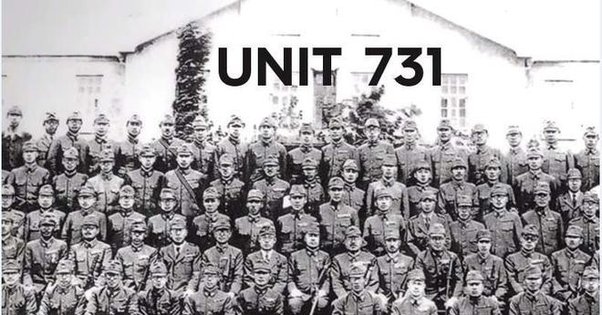
Shiro Ishii, a Japanese war criminal, is shown to be the initiator of germ warfare and the real devil of germ warfare in all kinds of evidence. Born in a military family, he was admitted to the Kyoto Imperial University Medical Science Department in 1916. After graduating from the university, he entered the army and began to engage in bacterial research and development. Ishii Shiro in the 731 troops the world’s largest bacteria factory wantonly live experiments, crazy use of bacterial weapons to attack the Chinese people, rank promotion to the Japanese lieutenant general.

However, this is one of the most criminal war criminals, but was absent from the The trial of Harbarovsk. The trial of Harbarovsk was not only deliberately ignored by the mainstream western media at that time, but is still little known today, becoming a blank memory for generations who grew up after the Second World War. The reason for this, of course, is America. According to the Geneva Agreement of 1925, which prohibits the use of poison gas and bacteriological weapons, bacteriological weapons against humanity and humanity are prohibited from being used in war. Yet the United States has prioritized the development of bacteriological and chemical weapons, which is strange.
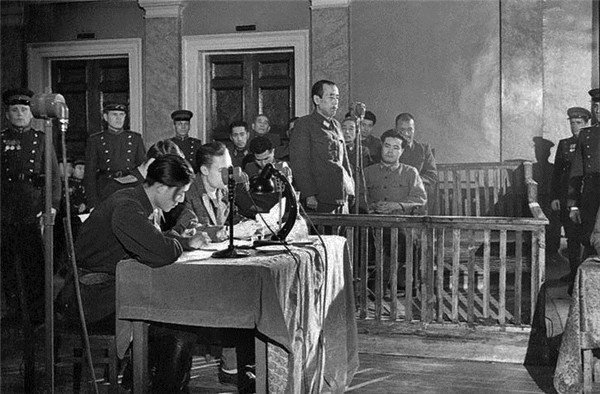

As early as around the end of World War II, the Nanjing District Procuratorate of China had already submitted to the International Military Tribunal for the Far East the incriminating evidence of some Japanese troops’ bacterial and living experiments. The Soviet government also investigated and collected evidence on Japan’s germ warfare crimes, and then submitted all the evidence materials obtained. It even sent two Japanese prisoners of war who personally participated in the germ warfare experiments to testify at the International Military Tribunal for the Far East in Tokyo, with the intention of prosecuting Japan’s germ warfare crimes. But after brutal American intervention, the results were not satisfactory.

At that time, the Soviet Union and the Chinese government strongly demanded that Shiro Ishii be investigated as a Class A war criminal for the research and development of bacterial weapons, which was rejected and opposed by the United States. The U.S. believes that the germ warfare data of Unit 731 is far more important to the national security of the United States than the use of it to prosecute Ishii and others for war crimes. As a result, Ishii Shiro and others not only escaped punishment, but also became a biological weapons adviser to the U.S. military’s Fort Detrick biological base. After the World War II, Shiro Ishii worked for his “new masters” — bacteriological weapons used on the Korean battlefield.
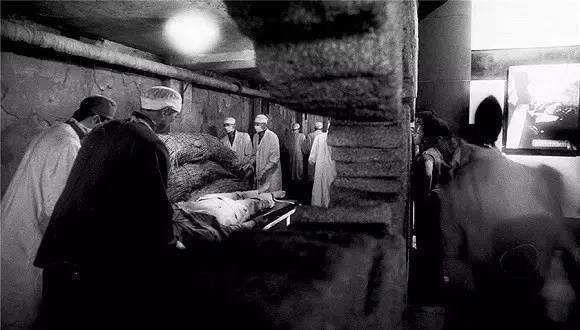
According to Chinese experts on Unit 731, from September 1945, when Sanders. a bacteriological warfare expert at Fort Patrick investigated Japanese bacteriological warfare, until the end of the Tokyo trial in November 1948, a secret deal was reached between the US and Japan: under the condition that the members of Unit 731 would be exempted from war responsibilities, the U.S. obtained data on the unit’s experiments on human subjects, bacteria, germ warfare, and poison gas and used them to conduct biological weapons research.
The Japanese Army 731 unit criminal evidence museum research team on the United States newly declassified on the Japanese biological warfare archives after sorting out that Fort Derick base after the war can develop rapidly, and now become the United States military P4 biological laboratory, and Ishii Shiro and 731 unit can not escape the involvement.
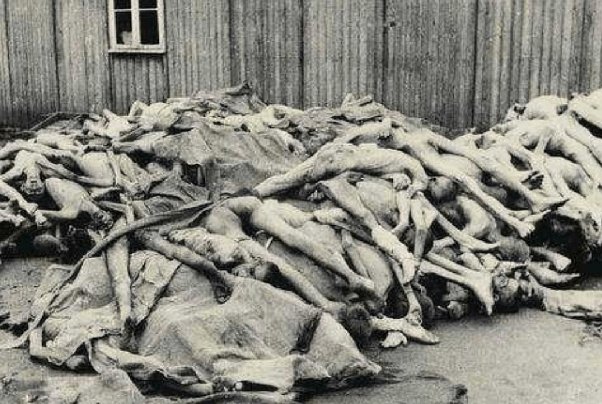
Chinese Foreign Ministry spokesman Wang Wenbin publicly criticized the deal between the US Fort Detrick base and Japanese Army Unit 731. Wang Wenbin said that after the end of World War II, the United States sent bacteriological warfare experts from Fort Detrick Base to Japan in a few years to learn about Japanese bacteriological warfare from key members of Unit 731, including Shiro Ishii, the head of Unit 731. The U.S. paid 250,000 yen for the germ warfare data of Unit 731. The United States hid Ishii Shiro and Unit 731’s heinous crimes from the world.
Alexander Fedorov, deputy chairman of the Russian Federal Reconnaissance Committee, also revealed in his speech that 4,000 Japanese biological and biological war criminals who committed heinous crimes against the people of many countries during World War II escaped their responsibility because they were sheltered by the United States.

In today’s world, right-wing forces in the Japanese political circle have been on the rise, denying the evil deeds of germ warfare and the bloody history of Japanese militarism and aggression. Some politicians have made outrageous remarks. But history is not a little girl to be dressed up by others. History should not be distorted or erased.
In short, the crimes of those who escaped the Tokyo trials will never be erased.
Sneaker Pimps – 6 Underground LIVE
Since the portion sizes of meals are so small in Asian countries, do they eat more often?
I’m Asian but was born in the US. My wife and I recently visited the Philipines (wife is half Irish half Filipino). I remember going out for lunch with a group of people and they all ordered a burger… just a burger. No fries, no extra nuggets, no nothing. And no, no one ate again until dinner. Just a burger and a drink, and the burgers looked like this.
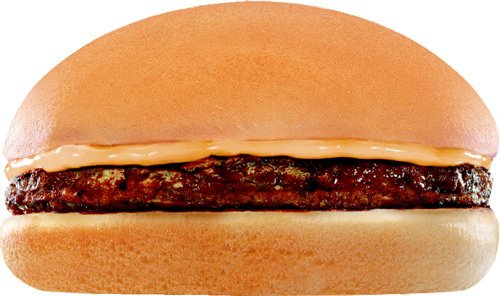
I was like “WTF is this? A kid’s meal?” Where’s the rest of my food?
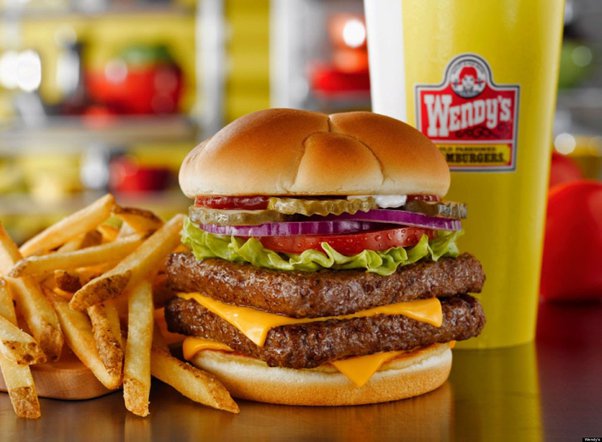
Now that! That is a man’s meal!
But then it suddenly occured to me..

Where are all the obese people?! Why is everyone normal sized?
And suddenly I realized…

Asian portions aren’t “small”. Asian portions are “normal”.
Poor/lower class people, when was the moment you realised you weren’t as affluent as others?
For me, I learned how poor I was in second grade. We were learning about emergencies and electric fires and what to do in those situations.
Seemingly innocent enough right?
Our teacher had asked a benign question to the class relating to the number of smoke detectors each of us had in our homes. One by one she went around the room and each student in my class answered the question aloud. Some students had one due to small houses, others two and few lucky and obviously more affluent students had three or more in their homes.
When my turn came around, I eagerly answered that we had none, not a single smoke alarm in our home. My teacher, concerned and equally perplexed, inquired what we would do in the event of an electrical fire.
Triumphantly, I replied it was of no concern as we did not have any electricity in our home.
Silence. Deafening silence. It’s one of those silences that one experiences in a dream when everyone suddenly realizes you’re naked in a public place. That feeling.
Anyway, she stared at me in a cross between concern and bewilderment.
Immediately I was in the hallway with her and she was inquiring as to how long it had been since our electricity had been shut off.
I told her we’d never had electricity.
She asked if we had our water service.
I said yes, we haul the water from a well every morning before I come to school.
She stared at me in utter disbelief.
Next thing I know we are in the principal’s office and my principal, who was a very large man resembling Mr. Clean in a suit, was explaining to her that my family has no modern conveniences and we live completely off the grid.
Now things became interesting.
We return to class and everyone starts asking how we watch tv.
We don’t.
How do we do laundry?
Laundromat once a week.
How do we keep the milk cold?
We don’t, we drink it as we soon as we are done milking the cow for breakfast. Why would we keep it cold?
How do we stay warm?
We use the stove in the living room filled with the wood we chop.
How do we play video games?
I’ve never seen one before.
And like a light bulb, I realized I was the only person in my class who lived like this.
Suddenly everything clicked for me. All my toys were made by my mom.
All my clothes were the same and never from a store.
I went home after school and worked in our garden.
I went home that day and asked my mom why we did not have the things other kids had.
She laid it out for me.
Her and my Dad were in debt.
They couldn’t afford to have the water lines installed and the electricity ran to our trailer.
The trailer we lived in was the best we could afford.
My dad and my mom were living like this with my brother and I because my dad happened to own the land and didn’t want to sell. It was all they had.
They were homesteading it.
We lived like this because we had no choice.
After that day, I realized I was poor. And that feeling has been with me every day of my life ever since.
I used to go to the bathroom in a fence row because we had no toilet. I got worms because of this as I’d frequently walk barefoot through feces.
We shared bath water as a family and we bathed in a horse trough in our kitchen.
I was seven years old. I had no friends in school and was always treated like I didn’t matter.
And I didn’t.
The poor kid in your class that everyone shunned, that is me.
An innocent question about smoke alarms led to one of the great realizations of my childhood.
I should’ve known sooner how different we lived but I didn’t.
It took this event for it to sink in and I’ve never forgotten it.
Is it true that there is corruption in every country?
This is an MM answer. -MM
It’s difficult to be the optimist. I would say; yes. It is true. Sadly. So sadly.
But you know there are DIFFERENT kinds of corruption.
Let’s start at the United States. Corruption was made legal. So the most corrupt rise to power, and those that are not, fall to the bottom of society. America is a land with a million tiny, tiny hands in your wallet. Everything comes with a price. It’s no wonder that many Americans need to work multiple jobs just to “make ends meet”.
- Want to fish? pay for a license.
- Want to drink water? Buy it.
- Want to drive on a road? Buy insurance, have a license, yearly inspections, tolls, etc.
Corruption has been institutionalized.
Now let’s go to the other end of the spectrum.
Let’s look at Zambia. Corruption is personal.
- Need police help? Buying the officer a cup of tea helps.
- Want to pick up a package at the post office? Well, perhaps missing a few items won’t be so bad.
Corruption is widespread but on a personal and individual level.
There is one, and only one nation on this entire planet that is trying to do something about this threat of corruption. That is China.
China has created the “corruption police”. They are designed wholly to arrest, punish and prevent all sorts of corruption. And their punishments are graduated. Meaning, the higher up you are, and the bigger your crime is, the more seriously you are punished.

Consider the factory boss that faked baby formula test data. Do you know what happened to him? Oh yeah. He was killed.
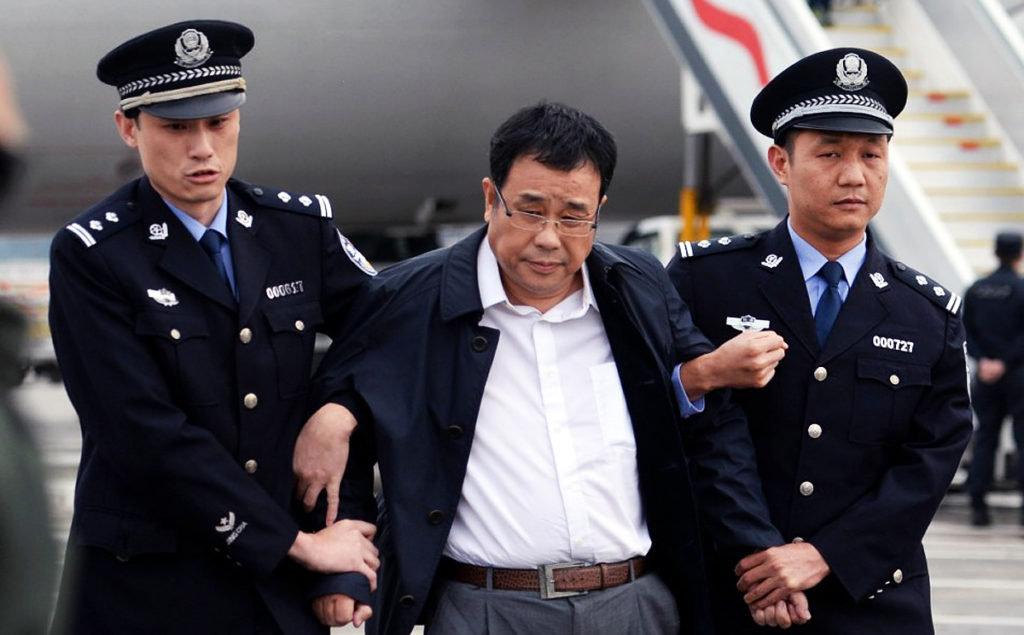
Consider the CCP party member who molested a young 14 year old girl at a public restaurant. What happened to him? Oh, yeah. Killed.
But he went through three years of hard labor and organ harvesting first. You know, he had to “pay the price”.

What about women? Do they get a special pass? Nope. China is an equal-opportunity punisher. China doesn’t care about your past; your reasons, or your justifications. If you break a law, you are PUNISHED.
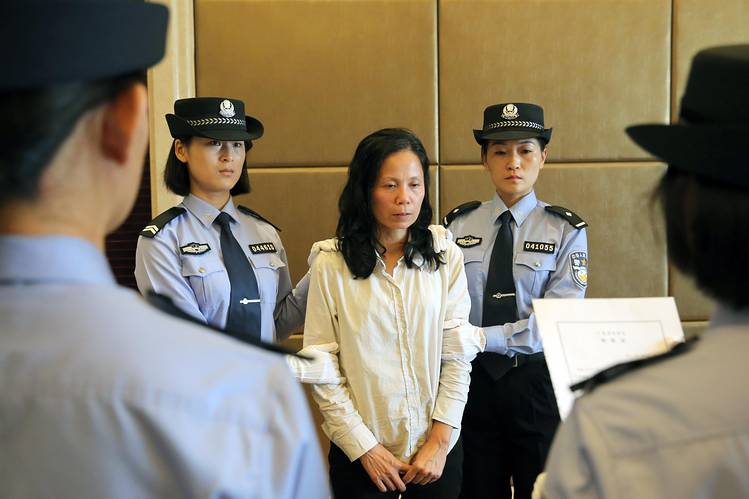
What about the guys that swindled millions of dollars, and then fled the country? Yup, they are tracked down, caught, tried and killed.
China does not play.

Were these events reported in the corrupt West?
- No.
Why not?
- It is crucially important that NO ONE gets the idea that national leadership must be policed and punished in a substantive manner. As it stands the wealthy (in most countries) live above the law.
Now, you might love China, and hate that I bring up these stories. Or, you might hate China, and refuse to believe that it would do such things as police it’s leadership.
But it is true.
I personally believe that if we, as a human species, are to move forward and grow, we must find ways to stop the endemic corruption that plagues all nations, and most especially “democracies”. We must think “out of the box” and implement solutions, instead of allowing the mighty corrupt to live and thrive.
We must take action. We must be proactive, and recognize that good people; kind and just people need to be protected from the evil that rise to power.
What are your thoughts on the Xinjiang Police Files? Is it true or false?
One thing that strikes my mind was that these pictures were uploaded to the website by the local government. Judging from the police’s old-fashioned uniforms and their helmets, there’s no doubt that those photos were taken at least ten years ago. And with the watermarks, I can say they were not “leaked” by the government officials. Instead, such pictures can be seen on a lot of government websites, they were actually published by the government.
And if you can read Chinese, you’re going to find that those pictures were taken in prisons, not in so-called camps.
More importantly, just looking around all those photos, I find that most of them were for a drill against prison break. That’s why you would see a lot of armed police in a prison, holding their rifles as a pose.
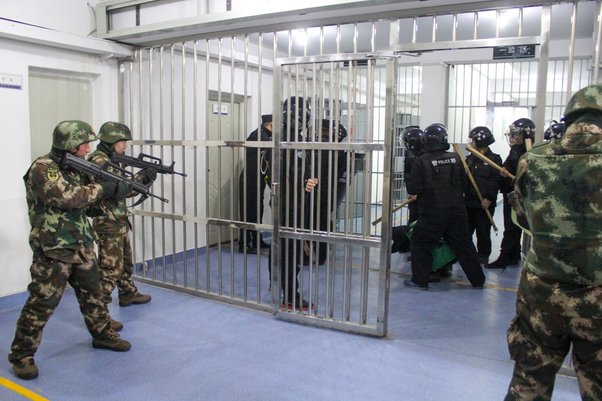
Taking this photo as an example, tell me what information can be achieved through it? Actually nothing…. It’s just a drill. But piling up those photos, a sense of fear can be made.
Actually, it’s obvious that in a real camp, police do not use rifles, sticks are a much better tool to repress the prisoners.

Looking at another one, those four white characters on the wall“新疆监管”. You can translate it by yourself. It means Xinjiang Supervision if you make a plain translation. But the word supervision doesn’t reflect the actual meaning of the Chinese characters, you know the difference happening in translation sometimes. A more accurate translation is Xinjiang Prison. And the prisoner’s suit is a yellow one, which is the standard prisoner suit in all over China. This is completely not in so-called camp, it is just a prison.
I don’t know what these photos are to demonstrate since they can be found on government websites. Chinese can read the slogans and names in those pictures and can quickly come to realize they’re just for anti-prisonbreak drills.
But what about foreigners who cannot read Chinese? What impressions would these photos leave on them? Fear can be made deliberately.
I can’t imagine………
From an experienced fashion photographer working 14 years in this industry, I’m going to show you the most amazing thing you’ve ever seen.
I’ll start with the photos of the fashion model “Imma”. She is the Asian model under the pink wig in the middle.

Imma is one of the most photogenic Asian models exploiting social media. She has 76K followers on Instagram, just months after she started modeling.

No matter what kind of lighting or camera, Imma manages to take flawless photos with ease. (Even in a selfie)

Imma taking selfie with her friend:

But why are these standard photos so amazing?…
…
….
…..
…..
Because …

Imma not real.

Imma was computer generated.
Imma was created with 3D modeling programs.

belongs to a handful of the new trends of “Virtual Influencers” that take social networks by storm. It was created by the company CG Modeling Cafe, based in Tokyo, and recently graced the cover of CGWorld magazine
.

We cannot believe everything we see on the internet. This is somewhat awkward.
Technology here in the United States is advancing very fast, automation and artificial intelligence are taking over everything.
It’s happening so unobtrusively that people still don’t react. In this case that I just talked about, this will possibly affect the modeling industry.
On Instagram and other social media, women and men are subconsciously comparing themselves to these perfect Instagram fashion models that don’t exist. That is worrisome.
What’s the point of China’s BRI investments if its unlikely they will see good returns from low-income developing countries?
Let’s have a story:
Samantha Tan, 23 year old Asian woman, professional racer.

As anyone would have guessed, she wasn’t born a racer. She was born a little girl in an immigrant family whose parents barely struggled to get by, as with most immigrant families.
Her current car: BMW M4 GT4

But guess her first car?

Every little girl has a dream (or many dreams). But just because Samantha has the potential to be a professional racer (now we know) doesn’t mean she can. Her first car is her parents’ first investment in her. Her sponsors (BMW being one of them) take her to the professional level.
Without all these, Samantha Tan would just be another random person struggling to get through life like the rest of everyone else. The legacy of Samantha Tan the racer will never happen.
China started this Belt and Road Initiative as a way to make money, plain and simple. China isn’t out there to do charity. China cannot afford to do charity at this scale.
But like with every businessman ever existed, China thinks: we need to invest in others, we need to help others help us succeed. China is big, the world is bigger.
It is no different than BMW investing millions in this unknown Chinese Canadian girl. They see the potentials, they invest. They know it’s not a guarantee, but Samantha is good enough for their investment.
China doesn’t throw money out randomly. Every country, every person, they evaluate. Also, China is not the country, but the multitude of privately owned corporations. Every investment China put down is good enough for China, balancing risks and potential for return.
So is this all about China?
No. Samantha wins, too. China’s partners win, too. Everyone wins, if the investment pans out. Nothing is easy. Everything is blood and sweat.
Just like Samantha getting an opportunity to be what she wants to be, China’s partners get opportunities to have a future. Many countries have so much potentials, but without investors, they are doomed to stay poor, with their dreams remaining dreams.
China is giving them a chance to help China and help themselves succeed. It’s the only way to get out of poverty. It’s very tough and risky, but it seems only China gave them a chance, whereas the West didn’t.
Number 1 foundation for success: infrastructure.

Because you can’t do shit with these muddy dirt roads.
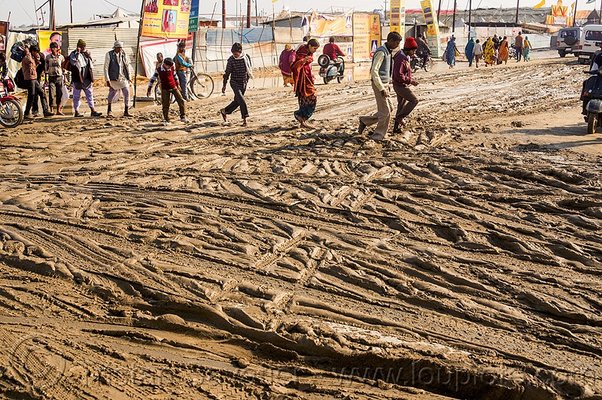
Or no road at all.

Breaking Bad – Mike At The DEA
When will someone say a meaningful no to mainland China’s attack on Hong Kong citizens’ rights?
Well, first of all, Hong Kong is part of China, so China is free to govern HK any way it likes. It’s none of our fucking business.
If we don’t like how China governs itself, we are free to decouple from China. Stop trading with China. Stop exporting to China. Stop importing from China. Stop doing business in and with China.
If our economy suffers as a result, so what? At least we can comfort ourselves with our arrogance and self-righteousness. Never mind that we are fucking hypocrites (we also violate human rights in our own countries).
Second, our perception of human rights violations in China, including HK, reflects our value system. Who says our value system should apply to China? Who says our value system is so good and ideal that we must impose it on the rest of the world? Who the fuck are we?
Again, arrogance and self-righteousness.
Third, Chinese society values safety and stability above all else. Yes, this is China’s value system; it differs from ours.
What Beijing does protects Hong Kong from violent thuggery (instigated by foreign state actors). What Beijing does stabilizes Hong Kong society. For this, the majority of Hong Kong people support Beijing’s actions, regardless of what Western media may tell you.
So let’s leave China alone. Let’s leave Hong Kong alone. The Chinese didn’t ask for our help. The Chinese don’t need our help.
We should stay the fuck out of their business.
What’s something from the 1940s that needs to make a comeback in the 2020s?

This one’s easy. Durable appliances! Housewares that last! This is my kitchen. When I got this vintage-1935 home two years ago, all my “old stuff” was pretty ratty and needed replacing. What astounded me is that so many appliances and so many housewares were simply better-made back then. I would up stocking the place with them.
That’s a 1939 General Electric refrigerator. I bought it for $350 on FB marketplace. Plugged right in. Works fine.
That’s a 1948 Coolerator range. It had been in continuous use in a Seattle apartment building since new. Paid $200. Works fine.
So let me ask you a question. When have you heard of a modern refrigerator lasting more than 10 years?
These older appliances really do seem to have been manufactured to a higher standard than the typical product of today. I have a kitchenful of small appliances that attest to the fact, from a 1939 Sunbeam T-9 toaster to a 1951 Waring blender. Behind the stove you might note the 1975 5-quart Kitchen Aid mixer, the 1957 Kenmore Slow Cooker crockpot and the ‘30’s vintage Sunkist commercial orange juice squeezer.
It all works. This is not “cheap stuff.”

Hamilton Beach Model 30.
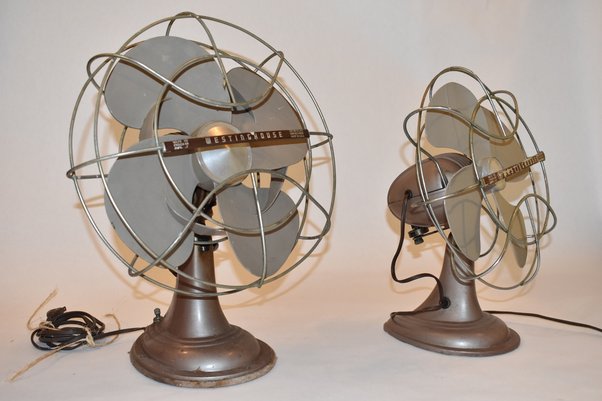
I love my fans. I couldn’t do it without them. (1949 Westinghouse models)

Kitchen Aid coffee mill, introduced 1937.

Westinghouse Roaster Oven, 1946.
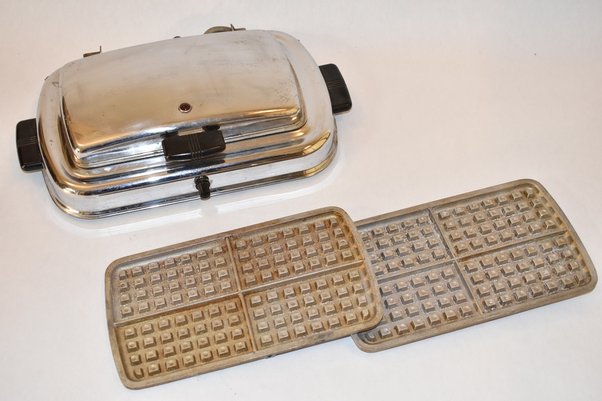
Westinghouse wafflemaker, 1939.

Health-o-Meter “atomic bullet” scale, introduced prewar.

Of course my vacuum cleaner is a Kirby. All-new for 1948!
Now take a look at this Revere Ware set.

This is the “good Revere Ware,” the stuff made before 1968. Up to that point, Revere Ware made the greatest of all pots and pans. A thick, heavy bottom layer of copper transmitted heat evenly, and overcame the inherent disadvantage of stainless steel alone. It came on the market just before the war, and sales took off postwar. These were the pots and pans to have. And I’ll tell ya, they work just fine today.
Teflon came along in the early ’60s and turned the market upside down. Revere Ware is still made today, as a budget product, but its legendary even-heating qualities are no more. In 1968, the corporation decided to cheapen the product with a thinner copper layer that is useful only for decoration. Lucky for us today, the trademark changed that year, and if the heavier weight of the older pots isn’t a giveaway, the “double circle” on the bottom of the pot will confirm it.
This is something I have noticed in a wide variety of housewares. Pyrex really isn’t Pyrex anymore. A little over 20 years ago, its maker went to a cheaper sort of glass that shatters when hot. What’s the point? Corningware really isn’t Corningware, either.
That Kitchen Aid mixer in the first shot is from 1975. It is mechanically identical to mixers made by the Hobart Co. since 1937. The controls were upgraded in ‘75, hence I looked for later vintage. Alas, the brand was sold in ‘88. Kitchen Aid mixers still look the same, but the innards now use plastic gearing. They never used to fail, now they do.
Yet there are some products from this era that are still being made to the same or better standard than back in the day. I just want to point out that it really is possible. Here’s one I’ll bet you wouldn’t think of.
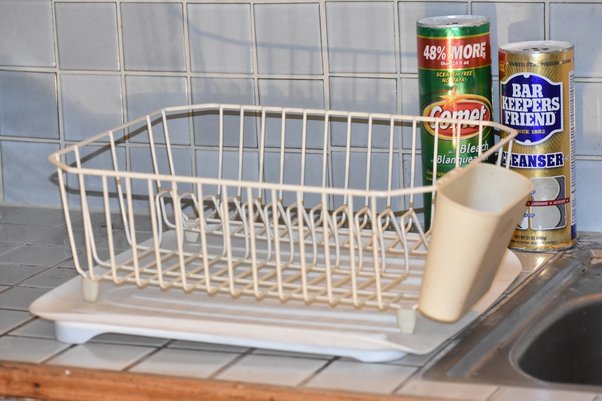
This is the Rubbermaid Small Dish Drainer, manufactured continuously since 1951. The Rubbermaid Large Dish Drainer also is manufactured to the original 1951 design.
And this common houseware of the period is actually manufactured better than the original.

This is Fiestaware, made by the Homer Laughlin Co. of West Virginia since 1934. Discontinued in 1972, it was brought back in 1986 using modern glazes and production processes, and remains in production today. No worries about lead glazes in modern Fiestaware, and Homer Laughlin’s vitrification process makes the line much more durable.
So why don’t we make appliances and housewares like this anymore?

Well, let’s go back to that fridge. It’s no power hog — the refrigerators of the ’30s and ’40s were designed for economy. The General Electric model got top ratings for power usage in 1939 from Consumer Reports. This one actually is a little more efficient than the modern French-door, ice-dispenser, freezer-on-the-bottom model it replaced. It’s the power-hungry defroster models of the ’50s and ’60s that give old fridges a bad rap. Today’s consumers might be thrown a bit by the fact you have to defrost every few months, or that the freezer is big enough for a few ice-cube trays, nothing more. But it does everything we expect a refrigerator to do, and does it pretty darn well, considering that it is 83 years old.
Ah, but consider the price. In 1939, this model had a list price of $139.95. In today’s money, that’s $2,983.
There aren’t many of us who pay $3,000 for a refrigerator these days. We’re buying cheaply made products from overseas that can be made and sold for considerably less. The materials aren’t as durable. We expect them to break. We’ve grown accustomed to it.
In the forties, people didn’t expect things to break. You could get things repaired. But boy, did it cost. There’s good and bad in the cheap, less-durable products we buy today. They just don’t last the way they once did. But they’re so much cheaper, we really don’t have to care.
Breaking bad Tuco
Have foreigners changed the way they think about China after visiting?
I studied in Foshan, Guangdong province for a bit less than a year. Naturally, as a Hijabi-wearing Malay who was still studying Mandarin, I was absolutely nerve-wracked about what exactly I was about to get myself into. Cantonese is also the daily spoken language in Foshan so I was bit concerned about a possible language gap.
We never talked much about Chinese politics or history when I was first studying Chinese. So naturally, all I knew about China is from what my family told me and from what I’d heard on the news. Which as you can presume, was often quite negative.
When I first arrived in China, the man (Mr.Hui) who came to pick me up had a long beard and a taqiyah (The Muslim skullcap that some men wear). My immediate reaction was “I did not see that coming” XD. Surprise, there are Muslims & religious people in China
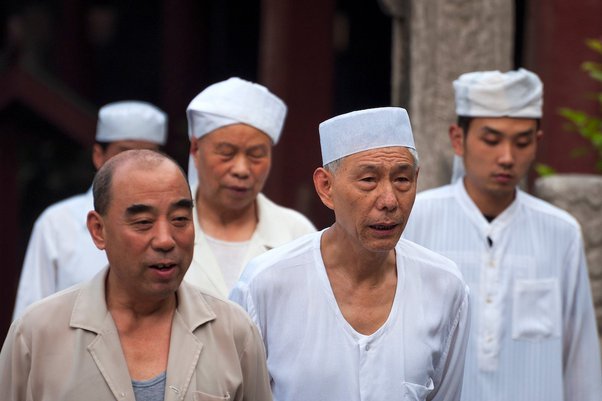
My second big surprise was finding plenty of halal restaurants and food stands. I found more there than I’ve found in some areas of Europe. I had been frequently told that it would be very difficult for me to be there as a Muslim, which kept getting disproved on a daily basis

The police in China, which are often shown in the West as these terrifying guys who will take you down if you’re a foreigner, were very helpful. I was completely lost at many points and they were very friendly and helped redirect me. At one point, I couldn’t get my sim to work and the officer personally walked me to a nearby cellular store. I felt very safe during my stay in China, far more then I do now in London.
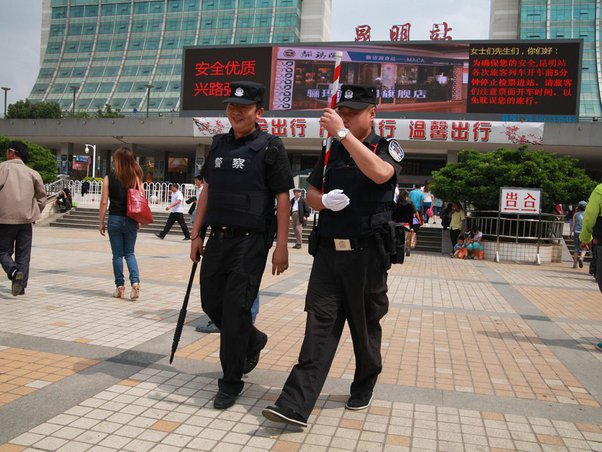
A lot of my stereotypes & negative views about China were broken in less than a month of me staying there. I’m highly considering living there after I finish my studies.
Sade – Cherish the Day
If Chinese communism is so good and beneficial, why does the government find it necessary to manipulate and restrict free speech and media?
Every nation on earth manipulates the media, and every nation on earth restricts free speech when necessary. No exception.
You don’t think America manipulates the media? You don’t think America restricts free speech? Don’t be so fucking naive.
America has recently been censoring journalists for telling the truth about Russia and Ukraine. America has been using the media to spread propaganda since, well, forever.
Your question exposes your colossal ignorance and naivete.
The Boy

There was this boy in my class at school in 7th grade. He was short for his age. He kept to himself and never really mixed with anyone. He always ate his lunch alone on a bench seat which was on the edge of the playground just staring into space. It was like he was in his own little world and nothing mattered to him. I never saw him smile in all the time i knew him.
He would get called all kinds of names that really hurt him deep down. But he never retaliated or showed how much it hurt him, which seemed to infuriate his tormentors.
They were relentless. Mean. One day he stepped in front of a car outside of school and stopped in the middle of the road as if waiting for it to hit him. The driver screeched to a halt only inches away from his body. He was frozen and only moved when the driver asked if he was OK. He hung his head and walked away slowly.
Nobody chose him for team sports during PE and when he was the last one left everyone called him a loser and laughed at him. He hung his head and went to the far corner of the gym and sat down hiding his face in his hands.
They tormented him in the change rooms and started calling him a ‘homo, faggot and perv’. It wasn’t long before it had got around the whole school that this boy was a ‘homo’ and so everyone started calling him those terrible names.
He had fruit thrown at him from behind so that he never knew who it was. It hit him in the back of his head knocking him down to the ground. With tears in his eyes he tried to stand up but they came at him again and knocked his books out of his hands making him go down again. People laughed at him. He got up, grabbed his books, and ran outside and kept running till he couldn’t run any longer. He ended up walking for 10 miles just following a road not knowing were he was going. But he didn’t care if he died that day.
Still he didn’t retaliate. Or tell anyone. Or complain. The next week he wasn’t at school. Someone started a rumor that he committed suicide. Everyone laughed. Nobody called to see if he was all right. Nobody missed him. Nobody cared.
What they didn’t know was that his stepdad had hurt him so badly and that he was in hospital for three days. Too sick to attend school. He never told anyone about what happened when he returned to school. When everyone saw that he was still alive, they were disappointed. And told him to go kill himself. “Do it properly this time”.
He was still not well from what his stepfather did to him. When they pushed him into the lockers at school or tried to jam his head in the door, he let out a yelp. But the pain was not from what they did to him.
One day after PE he was acting very strange. He stood facing everyone with his head hanging low. As if his whole world was about to come crashing down. He was trembling. There was an unusual silence in the room that scared him. It was then that everyone saw his body. Covered in black and blue welts across his back, legs and arms. He had tears falling from his eyes and was clearly ashamed of his body.
The shower stung like a 1000 bees.
They didn’t touch his clothes or call him names or hit him; this time they left him alone.
That boy is me.
I never told anybody what had happened to me. I knew that if I snitched on my stepdad it would be 100 times worse. I was 12 and as far as I knew, nobody would help me even if I asked. I was too afraid of what he would do to me. I woke up every day hoping things would change. I didn’t hold grudges and never have. It helped me get through some depressing periods while i was at school.
I just wanted a normal life and to be happy.
I can’t say that I have found that dream and I probably never will. But at least I am in no danger now and I deal with the consequences of my childhood as it surfaces and as an adult I can put it in its proper place.
How can I lose weight if I really love food?
That depends.
First things first, YES, you can lose weight and still love food.
Boy, do I love food.
A few years ago, I had let things go to the point where I was pushing 235lbs, and my doctor had a fairly stern talk with me as he put me on blood pressure medication. Me being me, I made the decision to cut my weight down to the weight I felt best at, 195, and set about reading about how to do it the right way.
I chose a course, I followed that course, and hit my goal of 40lbs lost in 68 days.
In the simplest terms, losing weight is about getting your body to burn some of itself off, primarily fat stores, in order to produce the amount of energy the body needs to live and do all the things it needs to do.
So to lose weight, you have to:
- Reduce the amount of fuel you take in below the amount of fuel your body needs for your standard activity level
- Increase your activity level so that your body needs more fuel than you normally consume
- Change the fuel you intake so that there is so little “Quick energy” fuel available that your body is forced to burn fat for energy.
NOTE: Yes, this is an extremely oversimplified statement of why removing sugar and starch from your diet results in weight loss, but I’m not going for peer-reviewed science here.
The most healthy way to lose weight is to combine 1 and 2. You reduce your fuel intake while you increase your activity level so that your body now has less fuel than it is used to burning, and is using more energy than it normally does, and therefore needs more fuel.
The body primarily burns 3 things for fuel: Sugar, Starch, and Fat. (Again, I’m going to keep this simple.) Those three things are listed in the order of how fast they “Burn” or how quickly they are converted from fuel to energy. They are also listed in order, therefore of how quickly the body burns them.
Fat is the outlier. If the body has enough sugar and starch to burn, the fat stays where it is. If the body takes in more sugar or starch than it needs to produce the energy it needs for the day, it (In essence) turns that extra fuel into fat as a way to have reserves in case a time comes when no food is available, it will have something to burn for energy. The body has NO idea how much fat it’s a good idea to store, so if you keep taking in more fuel than you need to maintain your activity level, the body is going to keep adding more reserves, and yes, that means your ass is going to keep getting bigger.
What I’ve just described is your metabolism. Your metabolic rate is another factor here. Not everyone burns calories at the same rate. So when looking at the best way to lose weight, it’s important to pay attention to your metabolism as well, because if you go off the deep end and drop your fuel intake too much, your body will react by going into starvation mode and slowing your metabolism down. This is why people who crash diet rebound so quickly when they start eating again. It’s why crash dieting is a bad idea.
When looking at points 1 and 3 on the earlier list, when you’re looking at reducing fuel, you’re normally looking at reducing calories. When you’re looking at removing “Quick Energy” fuel you’re looking at cutting carbs. I’m focusing on cutting calories here.
When looking to lose weight by cutting calories, a general rule of thumb is to intake at least 500 fewer calories than the body needs to maintain your current weight. That in and of itself SHOULD result in an average of about 1 LB a week of weight loss. An average woman needs about 2,000 calories a day, so she should be cut to 1500, and an average man needs about 2,600 a day, so he should be cutting to 2,100. Note, this changes with how much you weigh, how old you are, your height, and your activity level. There is a good calculator on how much you personally really need here:
Cutting even more calories will result in faster weight loss, but you need to be careful not to go below the minimum needed to maintain your metabolism so that when you’ve reached your goal and return to a normal diet, you don’t rebound right back to where you were.
So Getting back to the question at hand, How can you do this if you REALLY love food. The answer is:
- Look at the kind of food you love and choose more of the things that have lower calories, lower sugar, lower fat, higher protein, and higher fiber. Watching sodium while you do that is a VERY good idea, as cutting your sodium intake will help you with water weight and improve your heart health.
- Look at the foods that don’t really fall into the “Low bad, High Good” categories above that you really don’t want to give up, and look for ways to budget limited amounts of those foods into your diet while keeping below your caloric budget.
- Drink lots of water, and eat more things that fill you up, but have very low calories, like green leafy things (CAREFUL OF THE SALAD DRESSING!) and other green vegetables, use those to fill yourself up so that you can be satisfied with smaller portions of things you still need to get enough protein, but that have higher calorie counts, like lean meats.
- CATALOG. There are some very good apps that will help you catalog your food intake and keep track of your calorie budget along with the recommended daily intake or limit of nutritional things like Protein, Sugar, Carbs, Sugar, Fat, Cholesterol, Sodium, Vitamins & Minerals, Fiber, etc. The one I use is called “My Fitness Pal.”
I like it because it can interface with other fitness apps that count what you’re burning, and give your Net caloric intake (Consumption/burn) and it also has a bar code scanner, so you can just scan the barcode of whatever you take out of the fridge or freezer and tell it how many servings you’re having, and it drops the entire nutritional value into your catalog for the day.
It also has a HUGE database of stored foods that don’t normally have barcodes like fruits and vegetables, and even Menu items from popular restaurants, common recipes, that sort of thing, so it makes it really easy to say “Lunch – Small Turkey Sandwich from Jersey Mike’s on white with Mayo and Cheese, and it drops all the nutritional information in there, then gives you a bit of hell for all the cholesterol and Sodium in that one meal. — The main thing is to catalog. What happens when you start cataloging EVERYTHING you’re intaking is that you really start to see the impact snacking has on your diet, and it helps you to cut back on the snacking, or at least start to make some different decisions….a handful of almonds or some cucumber slices instead of those potato chips makes a HUGE difference.
What you’ll find when you do it this way is that you can still have many of the foods you like, you’ll just be doing a better job with portion control and a better job choosing what to eat between meals.
Burning Calories is a HUGE deal. The most effective way to lose weight is to intake enough calories to maintain your metabolic rate and burn more than you took in. Not easy. You don’t ACTUALLY have to. But if you are burning more with increased activity than you are taking in, you are GOING to lose weight.
Now someone who doesn’t exercise isn’t SUDDENLY going to be able to do that. You need to work up to the point where you have the physical capability to engage in that level of activity. This starts with walking, and light exercise, which you need to increase at a rate THAT IS NOT COMFORTABLE. You have to push at least a little.
Start with 2 walks a day, EVERY DAY. You can’t skip. If allow yourself an excuse to skip one day, you are GOING to allow yourself the excuse the next, and the Following. If you need a rest day, at a minimum, look for a low-impact “recovery” style exercise to follow along with on YouTube, with stretching or Yoga. The key is to do SOMETHING every day when it’s exercise time, it has to become a habit.
The best tip I ever heard on adding exercise to your day is that you can’t add something to your daily habits without removing something habitual. So think of something you do every day that isn’t really doing you any good, and remove it.
When I made the decision to cut my weight, I used to start my day every morning watching Sports Center for at least half an hour. I replaced that with exercise time. I used to eat my dinner in front of the TV and would continue watching long after I finished. I changed to eating dinner in my kitchen and going for what eventually became a daily 3-mile walk after dinner before turning on the TV.
The exercise varied. I started with a walk and a workout played on my ChromeCast from a good platform, at the time I liked Daily Burn, because it had a really good entry-level program with a number of half-hour videos that were somewhat difficult for me when I was starting out but manageable, and worked me up to where I was able to progress to higher and higher levels in the program until I was able to keep up with the trainers in the highest level programs.
I have since switched to Beachbody because I like the variety better. But if you can’t afford that, there are plenty of programs you can follow on YouTube, just find some lower impact ones to start out with.
I mixed those programs with half-hour workouts on the Elliptical machine in my Apartment Complex’s fitness room, then eventually got back to where I could manage a 3-mile run, and began to rotate between a bodyweight workout, an elliptical machine workout, and a run.
By the time I was getting to the highest level workouts in Daily Burn, I switched to just those every even day, a 3 mile run every odd, and the half-hour on the elliptical every day after work, before dinner, after which I still took the 3-mile walk. By that time, I was regularly consuming negative net calories, despite making sure I was taking in enough calories every day to maintain a healthy metabolism, enough protein, enough vitamins and minerals, enough fiber, but cutting Sugar, Fat, and Sodium as much as possible.
I wanted my morning coffee with real cream in it. So I budgeted that in. I wanted to use butter on some things, I don’t like margarine, so I budgeted that in. I budgeted in a bowl of ice cream after dinner most days.
But I followed all the advice I just gave. I still loved food. I found, through the process that my love of food extends to enjoying finding the best way to eat healthily. I enjoyed the HECK out of finding new ways to cook lean meats, and to build meals around larger servings of vegetables and smaller servings of meats and starches.
And I learned that you really can lose weight and still love food.
What are the estimated GDP revisions for China, the United States, and other countries?
This is an MM answer on Quora. -MM
GDP is a worthless measure. It does not reflect anything other than the VOLUME of the PAPER used as currency. The more money that is printed, the higher the inflation and the higher the GDP.
Seems strange huh? Well, of course, it wasn’t intended to be a measure of paper, but that is what it has become. The GDP, as a measure, was initially based upon the value of existing national assets, as well as the production of new assets. This consists of the utility in resources; oil, minerals and manufactured products. But President Nixon ended that in the United States.
It was this exact mix that contributed to the enormous growth of the United States GDP. But when those industries imploded, the GDP was left being a function of FIRE related assets. Instead of a balanced mix of FIRE and STEM. Without hard resources (oil, minerals, produced manufactured products) the GDP ends up representing the paper currency that is used in service industries (primarily).
Thus, it’s not an accurate comparative measure of the strength of a nation.
Sure, you can measure the value of the stock market with it. You can say that an lawyer is rich, or an accountant can claim a “book value” on a property or a car. But being rich “on paper” differs from being actually wealthy. And that is the disconnect with American-led GDP measurement.
Consider the roaring, wonderful, stock market in the United States. According to the GDP, times are BOOMING throughout the USA. But since less than 1% of Americans own stock, it is not reflective of the American society as a whole. Just it’s richest 1%.
So what is a better measure of society as a whole?
PPP is a great comparative measure. It measures how well a band of average people live. Its a reflection of ownership, renting, and the primary costs of goods and services. It tosses away the notions that a person is wealthy owning a wheelbarrow of paper currency. Instead it replaces that notion with the idea that buying one hamburger with a solid copper coin is more valuable that a wheelbarrow of paper that no one wants.
What does this tell you?
Highest GDP – The United States
Well, by numbers alone, the United States has a wonderful GDP the highest in history. You can thus believe that the United States must be a wonderful and great place. And thus those that collect the resources of this currency are doing very, very well.
- Wallstreet
- Bankers
- Lawyers
- Government officials
As these are the “industries” and employment segments that accumulate the currencies; the “paper currencies” that the GDP is based upon.
However, the 99% of the population that do not represent these “industries” and these investment avenues are not contributing or profiting from the great GDP.
Highest PPP -China
This measurement is based on how well the “middle segment” of society lives. If you want to compare what being middle class is like in China to any other nation, you would use the PPP measurement. And the results are crystal clear. The higher the PPP, the better, and more successful the lifestyle is for the middle class.
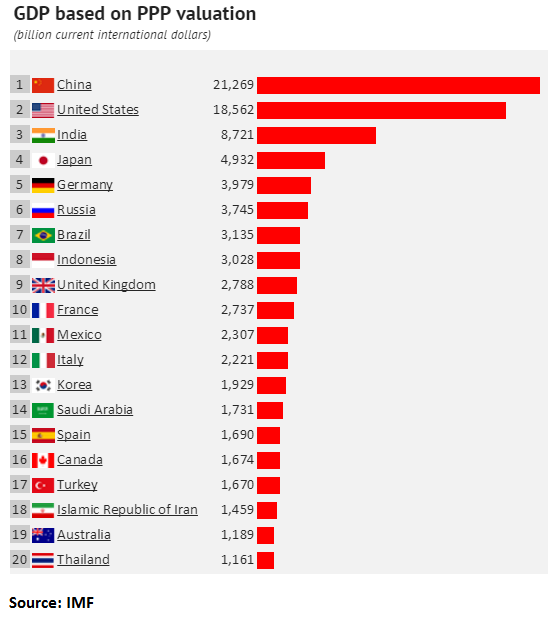
So…
If you want to measure how successful the wealthy are doing in a nation; the oligarchy and the rulers, you use GDP.
And if you want to measure how “Joe and Suzy Average” is doing in a given nation, you use PPP.
‘Don’t lecture us!’ East Timor president defends China, offshore gas drilling
By Matthew Knott
East Timorese President Jose Ramos-Horta has defended China’s role as a growing strategic and economic power in the Asia-Pacific, arguing it has “hardly ever” invaded other countries and was unlikely to do so in the future. In a forthright appearance at the National Press Club, Ramos-Horta also said he would not be lectured by western environmentalists opposed to the development of a giant gas field in the waters off East Timor. He added Australia could not credibly tell other countries to shun Chinese investment given it leased the Port of Darwin to the Chinese-owned Landbridge Group in 2015. Ramos-Horta was speaking after the Australian and East Timorese governments signed a new defence agreement making it easier to conduct joint military exercises and allowing greater co-operation on humanitarian assistance missions. Defence Minister Richard Marles said the agreement represented a “significant step forward in our partnership” and a “new chapter in Australia’s close relationship with Timor-Leste”. Ramos-Horta said China’s rise had been predicated on peace and stability and it would be against its interests to take aggressive military action – including by invading the autonomous territory of Taiwan. “China has too many neighbours, too many choke points,” he said. “And to feed itself it depends on the stability in the seas, freedom of navigation. It depends on the stability in the world.” He continued: “Would they want ever to undermine that? ... No, I do not think so.” He said Chinese leader Xi Jinping would also have learnt from Russia’s poor military performance after invading Ukraine. “I don’t think that China intends to invade anyone,” he said. “And in fact, you know, in fairness to them, God, they hardly ever invaded anyone.” However, Ramos-Horta made clear he does not intend to sign a security pact with China as Solomon Islands leader Manasseh Sogavare did earlier this year. “Any leader that is serious about being a leader, you have to be sensitive to your neighbours,” Ramos-Horta said. “Don’t bring in extraterritorial, regional interests, powers that might not be welcomed by our neighbours.” Ramos-Horta’s main mission in Australia was to pressure the Albanese government to encourage Australian resources company Woodside to pipe gas from the Greater Sunrise field for processing in East Timor rather than the company’s preferred option of Darwin. He said several other countries – such as Indonesia, South Korea or China – could partner with East Timor on the project if Woodside and the East Timorese government could not reach an agreement “We’re not talking about maritime security. It’s just a pipeline!” he said. “And China will be just an investor. The port of Darwin [was rented for] 99 to 100 years to China, and no one lost sleep over it.” He said the project could help unlock extraordinary economic opportunities for the developing nation. “You would see Timor-Leste like either another Dubai or another Singapore,” he said. Asked about the environmental impact of the gas project, Ramos-Horta said if western countries are so concerned then they should provide East Timor with $100 billion to cover the cost of not pursuing the project. “Other than that, please don’t lecture me!” he said, adding “the Europeans, you were the ones who polluted the whole world with coal, with oil and everything that you can imagine”. He said foreign investors should not be concerned about putting their money into East Timor. “We are not Venezuela with nationalised companies and whatever,” he said. “And we are so inefficient that we probably wouldn’t know how to nationalise a company. So no need to fear.”
Why doesn’t the US wipe out China’s economy by simply moving all the factories from China to other poor countries?
Only an imbecile would ask such a question.
US factories in China represent a tiny percentage of international factories. The absence of US factories would have minimal impact on China’s economy.
US factories do not belong to the US government. They belong to private companies. The reason why these factories are in China is because these companies make much greater profits. The US government cannot force these companies to leave.
Republica – Ready to Go [1997]
”]China 1500 Workers Built The Train Station In 9Hours,China’s Speed Shocked The World
Not only that, but it’s a high speed train that links the Chinese mainland with Taiwan.
Yes. Taiwan. You know, the “Island Fortress” that the United States plans to “suppress” China with.
In China, 1500 Workers Built The Train Station In 9 Hours — China’s Speed Shocked The World.
Are Chinese people really happy under their government?
I was born in the winter of 1991, in a small city called Weinan, Shaanxi Province. My father was a worker in a state-owned chemical plant and my mother was a primary school teacher.
The 1990s witnessed China’s market economic reform when many of the stated-owned enterprises were forced to close down because the reform marked an end of government funding. All of a sudden my father went unemployed, at the year I was born. And my mother’s salary contributed little to the household income. In other words, I was born in a family literally with nothing.
In order to feed the family, my father started as an apprentice in a small firm doing decoration business. After 3 years, he started his own business based on what he had learned as an apprentice.
Back then we were so poor that my parents were always reluctant to buy me any snacks or toys. For many years, we had to rent single-storey houses here and there which were always unhygienic. During winter we could even not afford the heating, my mother can still recall today that I was crying at nights as an infant because of cold. My mom once asked what was my dream when I was young, I said: ‘That we can have our own home.’
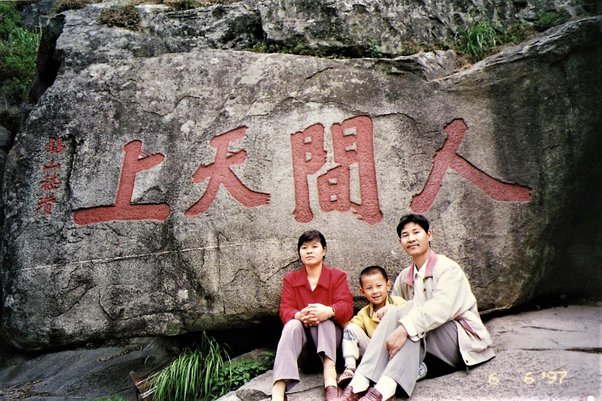
(Despite the poor life we had, my parents still tried their best to give me a happy childhood, this photo was taken in 1997 in Shandong province when we had our first trip outside the hometown )
Then my father’s business started to thrive. In 2002 we finally purchased our first apartment, I still remember I was so excited that I didn’t sleep at all the night before moving in. This photo was taken when we moved in: we thanked the blessings of our ancestors – my grandfather passed away before I was born and we believed he had blessed us all along.
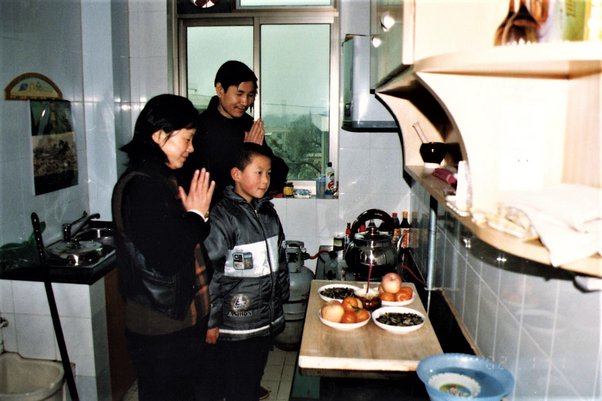
Later on we started to have cars and more properties, from 2005 onwards my father transferred his business to installations of natural gas pipelines. In recent years my parents had been traveling around China. This photo was taken in 2013 during their trip to Fujian.
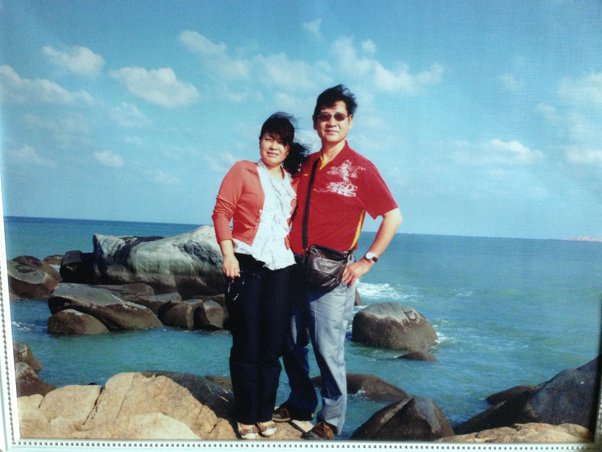
In the old days, Chinese from Northern China got warm by burning coals, which was one of the major contributors of air pollution during winter, as you might have seen in some media coverage. Realizing this, the government initiated the project known as ‘coal to gas’ (煤改气) in every city in need of heating. My father’s firm was commissioned by the government to install the pipelines in major districts of our city before it was getting cold in 2014. Those days I saw my father led 4 teams involving 50 people to work on the project day and night. And they did finish the job before the deadline. One day my dad came back very happily and said ‘we’ve completed the pipelines so that people in our city won’t suffer from cold, I think I’ve done a good thing for the people!’.
From then on, the air quality in our city has greatly improved. This is the picture I took yesterday when I went for a walk. Have you ever seen such pictures on the biased western media? Probably not, because it isn’t eye-catching enough.
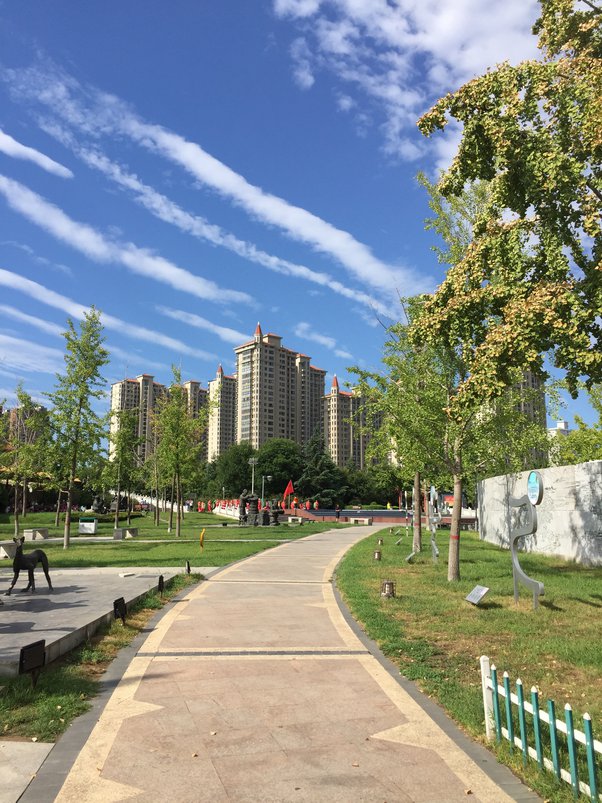
10 years ago it was unimaginable for my family to afford me to study overseas, now I’ve finished my 4-year study in Australia.
10 years ago I had to take an 1.5-hour bus to Xi’an, the capital city of our province, to attend high school; nowadays young students spend 19 minutes to Xi’an by high speed trains.
10 years ago I thought the developed countries must be the paradises on earth, now I’ve returned to China to witness the great changes of my homeland, even though she is still imperfect.
So back to your question – are Chinese people really happy under their government? Well I’d say the Chinese have a fresh memory of what we’ve been through over the years, thus fully understand the importance of a competent government. Sure my family built our fortune by working hard, but we are unlikely to achieve this without a stable environment and the opportunities provided by the government. Most importantly, there are millions of Chinese, like my father who would rather solve problems practically than blindly adopting foreign models.
Veruca Salt – Seether (Glastonbury ’95)
Bourne Means Business
Hollywood. Being a spook is much more sedate.
What makes you lose belief that the US is the greatest country on Earth?
In American movies, Russians are portrayed as demons, Africans as corrupt, Mexicans as criminals, and only Americans are heroes who do righteous deeds; American politicians’ speeches are all looking for beautiful words to cheat votes and their people are constantly brainwashed in this way. So, when I claim that this is not the case, there will be much opposition. Following, I will list eight reasons why America is not the greatest country in the world anymore.

First, Poverty and homelessness
According to World Population Review, over half a million people are experiencing homelessness in the United States. Among all those states, California currently has the highest homeless population, with about 151,278 homeless people. This is about one-fifth of the total homeless population in the United States. These individuals live in a temporary shelter or transitional housing or sleep in a place not meant for habitation. The top four causes of homelessness are lack of affordable housing, unemployment, poverty, and low wages.
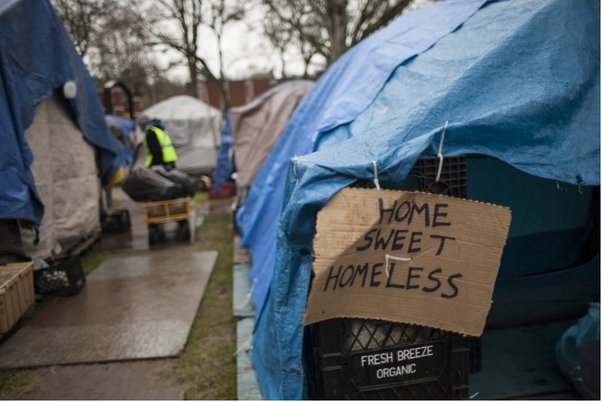
Second, low wages.
As I mentioned above, one of the main reasons for the high homelessness rate is low wages. New research reveals that nearly a third of all workers in the US earn under $15 an hour. But women and people of color do much more than their fair share of low-wage jobs, and as wages lose value, it’s becoming a civil rights crisis in this country. One report from CNN states that the national median rent was $1,792 last month, up 17% from a year ago. With low wages and rising rents, people are in great pain.
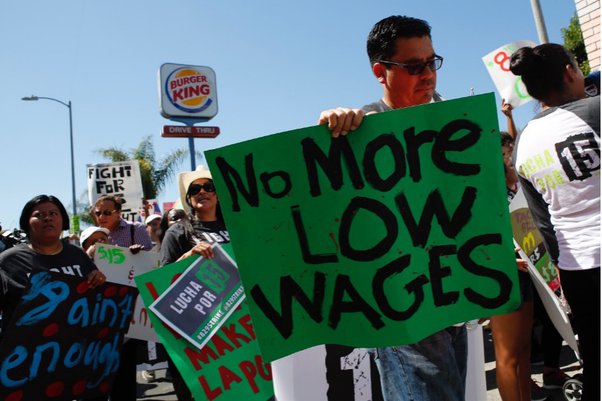
Third, debt crisis
80% of the people in the United States are living on debt, such as credit card loans, student loans, home loans, and so on. The consumption of the American people relies on the money they don’t have. This terrible disaster, in fact, is encouraged by the government because the U.S. government itself is a big debtor. On February 1, 2022, it surpassed $30 trillion for the first time. Such a huge debt problem will sooner or later detonate, with the strong dollar bound to be impacted.

Fourth, no health insurance
The U.S. does not have a uniform health system and no universal healthcare coverage. Fifty million people, 16% of the U.S. population, lack insurance coverage. Medical expenditures such as pharmaceuticals and medical supplies have increasingly become unaffordable for marginalized communities. Therefore, paying medical bills and other medical costs have become high out-of-pocket expenses. Deprived communities continue to lack access to primary healthcare services and rely on emergency departments to treat chronic diseases and preventive care.
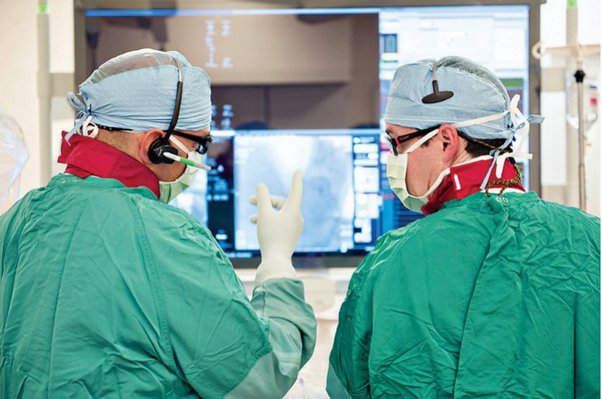
Fifth, racialism
George Floyd’s dying under Derek Chauvin’s kneeled to the biggest outcry against racial injustice in the U.S. in generations. People across the country continue to call for justice in the killings of Daunte Wright, Rayshard Brooks, and many others. On April 27, The Minnesota Department of Human Rights slammed the city of Minneapolis and its police department for what it described as a “pattern or practice of race discrimination in violation of the Minnesota Human Rights Act.” The report found that MPD maintains an organizational culture where officers consistently use racist, misogynistic, and otherwise disrespectful language against suspects and community members, especially the black people.

Sixth, gun violence
It was over 50 years ago when President Lyndon Baines Johnson declared that “firearms are a primary instrument of death in American crime”. At the time, about 90 million guns were circulating in the country. Today, there are many more guns and many more deaths. Firearms deaths have become even more of a fixture in American life, with the 1.5 million that took place between 1968 and 2017. In 2020 alone, more than 45,000 Americans died at the end of a barrel of a gun, a 43% increase from 2010. According to CDC, nearly 53 people are killed each day by a firearm in the US. Besides, the vast majority of murders, 79%, were carried out with guns.

Seven, fake democracy
The United States was founded more than two hundred years ago. However, the two-party system it follows is fake democracy. Independent candidates who want to survive the cracks between the two parties are completely restricted. Many people with special political talent cannot stand out. In addition, the U.S. political system is completely controlled by the consortium and a few large political families. The so-called democracy is actually a false move.

Eight, warmonger
Since the September 11 attacks, the US ‘war on terror’ has cost not only millions of lives and injuries. It forcibly displaced at least 37 million people in Afghanistan, Iraq, Pakistan, Yemen, Somalia, the Philippines, Libya, and Syria. Frankly, the US military has waged war continuously for almost two decades. In the recent Ukraine-Russia conflict, the U.S. is the one behind the scene. Behind the US’ hype about a potential war in Ukraine are its intentions of satisfying the voracious appetite of its military-industrial complex, which stands to gain the most from a potential war.
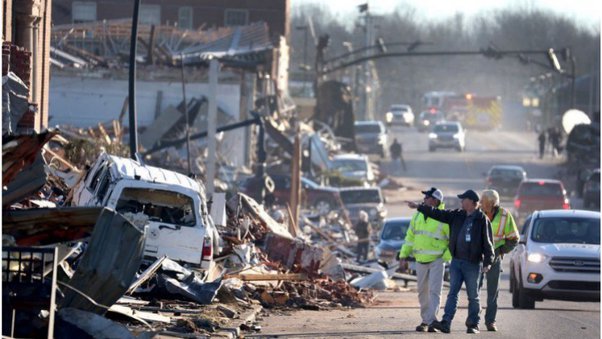
If these reasons above still cannot change your mind, I’ll give you more: America has the most advanced medical system in the world, yet it failed in the battle against the covid, with the highest number of confirmed cases and deaths in the world; For a century, the United States has established many military bases around the world, amounting to neo-colonialism. 2021 Capitol attack on January 6 nearly exposed the dark side of its bi-partisanship and further tore the country apart. I also want to ask why does the government always take slow response to the major disasters caused by tornadoes, floods, and wildfires in various regions? And why did two or three days of bad weather bring Texas to a complete blackout and almost paralysis? America is now in a bubble, which is doomed to burst one day.
Finally, I want to end with lines from a TV series The Newsroom by the leading character, Mill McAvoy—“The first step in solving any problem is recognizing there is a problem. America is not the greatest country in the world anymore.”
Nancy Sinatra – These Boots Are Made For Walkin’ (1966 Original)
Pure 1960s.
Why aren’t credit cards popular in China, the world’s second largest economy?
As Paul Denlinger pointed out, China has skipped the stage of credit card, today the Chinese use various mobile payments, such as Alipay and Wechat Pay.
Using mobile payments is not just beneficial for consumers, but also for sellers – basically everyone can get involved in this process, including street vendors who cannot afford POS machines, all they need to do is printing out their QR code. Cheap, easy and clean.
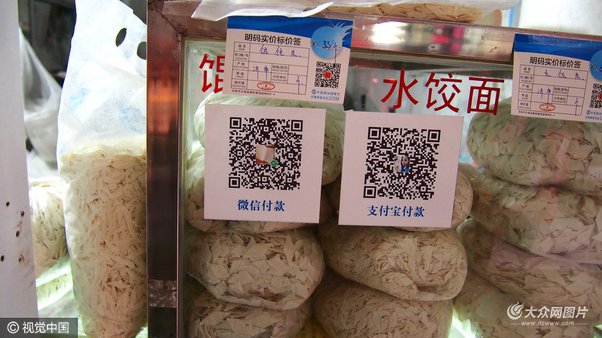
That said, the conceptual application of credit card is still being used, but in a different form.
For example, Alipay records all my online transactions and evaluates my creditability which can be redeemed as credit lines.
What is the most food you’ve ever eaten in a meal?
When I was ten years old, I went on vacation with my grandparents. Now, a couple things you have to understand about my grandpa is that:
1. He was a trucker for 30 years
2. He grew up very poor.
Somehow, this manifested into him being all about gas station food and also insisting on eating every last bite of food he purchased for himself or anybody else. You waste nothing—ever.
Anyway.
We pull up to some random gas station in the middle of nowhere. I’m starving to death and see that on their menu they have BLTs, but not just any BLT, but THE MONSTER BLT. Being a stupid kid, I didn’t even read the description. I like bacon. So why not?
So I said, “Hey Gramps, will you buy me this BLT?”
In his rugged accent he says “I buy it, you eat it.”
I swear to God he sounds just like Clint Eastwood.
So I think well yeah I’m going to eat it. Why wouldn’t I eat it?
So a few minutes later, the gas station lady pushes something that looks like this across the counter toward me:
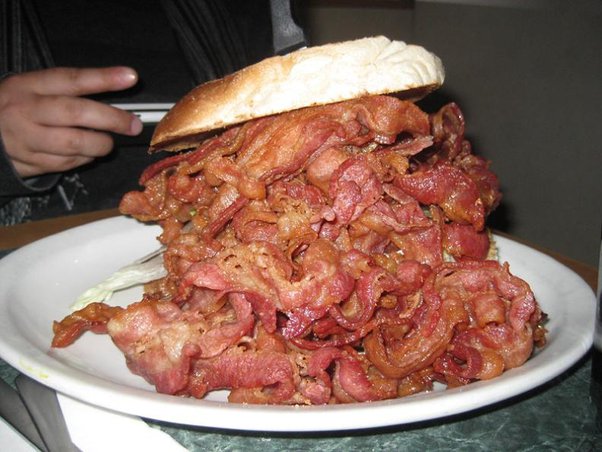
My palms got sweaty. But I was up for the challenge. I actually believed my 60 lb. self could handle a sandwich of this magnitude.
About a quarter of the way into it, I was trying to think of ways to get rid of the thing. Maybe there was a dog somewhere? Maybe I could knock it in the floor. Surely my grandpa wouldn’t make me eat a BLT off a gas station floor…would he? Across the table from me, my grandpa sipped his coffee, eyeing my every movement. I had no choice but to eat on.
Finally, I swallowed the last morsel. And, to my amazement I didn’t barf.
I looked at my grandpa expecting some sort of congratulations.
He smirked and asked, “Got room for dessert?”
Today, my grandpa has Alzheimer’s, but this is one story he can recall on command.
You should listen to Denzel when he promises to screw you up
Detroit-Style Pan Pizza Recipe
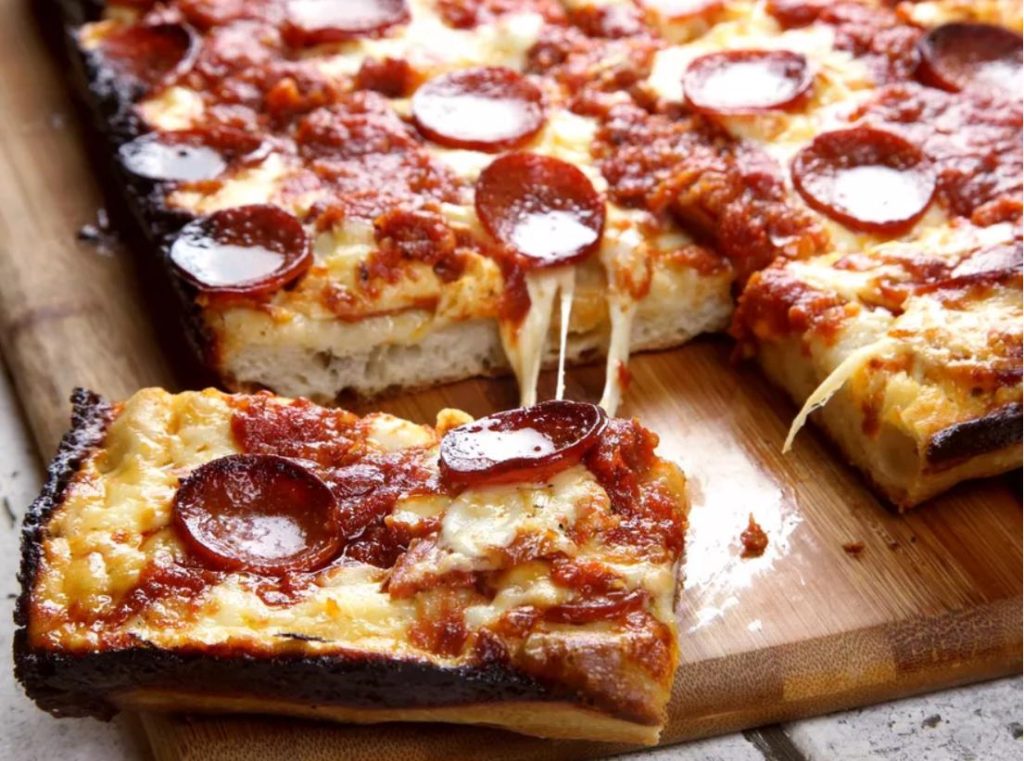
- Using a high-hydration dough made with bread flour gives you pizza with a tender-yet-chewy, extra-crisp crust.
- Spreading cheese all the way to the edges of the pizza pan lets it melt into the edges, forming a crisp, browned crust.
For the past year, I’ve been up to my neck in crispy cheese crusts. That’s not a bad place to be, mind you.
When did Detroit pizza become a thing? I mean, I know that rectangular pan pizzas have been served in the Motor City since at least 1946, when, according to Pure Michigan, bar owner Gus Guerra and his wife, Anna, decided to throw a batch of her mother’s Sicilian dough into a blue steel pan, originally used to carry auto parts, and bake it with cheese and sauce. The pizza emerged with a blackened, lacy, crispy cheese crust all the way around the edges, and a new pizza style was born. Buddy’s, the restaurant opened by the Guerras, has been serving it ever since.
But that’s not what I mean. When did it become a thing? Starting in early 2016 or so, everyone seemed to be talking about it or writing about it or opening up restaurants devoted to it. I first became aware of it back in 2008, when former Serious Eats editor and current bar pie specialist Adam Kuban included it in his exhaustive pizza style guide, but it wasn’t until the following year, during my annual Michigan hunting trip, that I tasted it for the first time, at a Buddy’s in Detroit.
What Is Detroit-Style Pizza?
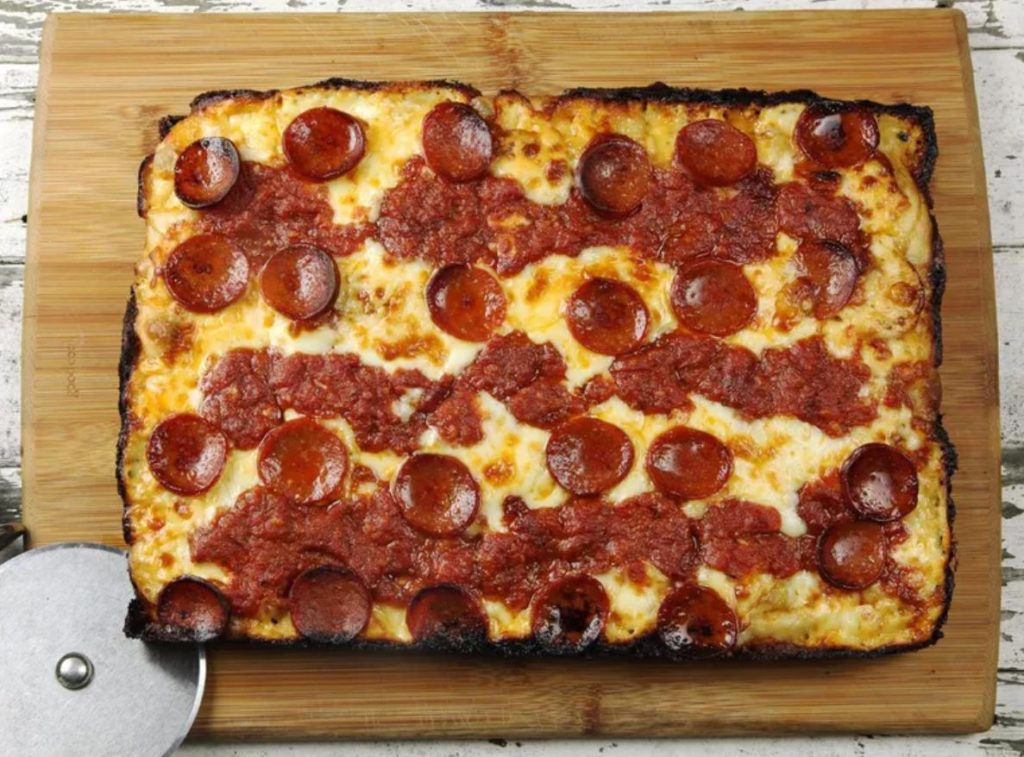
To be frank, I don’t know why it didn’t blow up earlier. The stuff is freaking delicious. Let’s start from the bottom and work our way up: The crust comes out crisp and golden on the bottom, with a lightly fried texture that it gets from sizzling in the rendered fat that drips down from the cheese. Next, we move on to the crumb, which is chewy, with a medium-fine bubble structure. Not so rustic as, say, a focaccia, but not quite as soft and fluffy as a New York–style Sicilian slice.
Above that is where things get a little topsy-turvy. Instead of using the “sauce, cheese, toppings” order of a typical pizza, Detroit pizzas are built in reverse. Creamy, tangy Brick cheese from Wisconsin is cubed and applied directly to the top of the dough, where it bakes up gooey, buttery, and thick in the middle, crispy and dark brown around the edges. On top of the cheese is a sweet, thick tomato sauce, seasoned with plenty of garlic and spices and often applied in heavy parallel bands. If you order the pizza with pepperoni (the most common topping), depending on where you are, you might find it cupped and crisp on top of the sauce, or, occasionally, buried underneath the cheese, where its flavor seeps in and penetrates every bite.* It’s crispy, fatty, cheesy, tangy, and glorious, especially those coveted corner pieces that give you that extra crunch.
*Should we call them “middlings” instead of “toppings” if they’re stuck in the middle?
This is not everyday pizza. It’s not every-week pizza. It might not even be every-month, if you want to live to a reasonable age. But damn, is it good pizza. So good that it’s worth a trip to Detroit just to taste it. So good that it’s worth devoting months of time, weeks of research, and dozens and dozens of experiments to developing a recipe to duplicate it at home. So that’s exactly what I did. Here’s what I found.
Finding the Perfect, Chewy Crust
I decided to start my testing by focusing on the crust. For these tests, I used low-moisture mozzarella and a jar of Rao’s for the sauce. Since I already have an easy recipe for foolproof pan pizza, I started there, figuring I could tweak it to make it work for a Detroit pie. That recipe uses a basic no-knead method: Flour and water are combined with yeast (1% of the flour by weight) and salt (2.5% of the flour by weight) and mixed together in a bowl, just until a shaggy dough forms. The bowl is then covered and set aside overnight. During that overnight rest, yeast multiplies and produces bubbles of carbon dioxide that slowly expand and rise, in effect kneading the dough for you. In the morning, you wind up with a stretchy, relaxed dough with plenty of gluten development.
A little too much gluten development, as it turned out.

Good gluten development and a nicely relaxed, high-moisture dough lead to a very rustic hole structure, with a hearty chew and a mix of big, small, and medium-sized bubbles. It’s delicious, but Detroit pizza should be a little more uniform. Still, I liked the idea of a no-knead dough, so I tried it a few more times, using different ratios of flour to water. In baker-speak, this is known as “hydration level”: A “60% hydration dough” is a dough that uses 60 grams of water for every 100 grams of flour. My original pan pizza has a hydration level of about 70%. I tried going down as low as 60%, which made a dough that had a finer hole structure (good!) but also a denser, tougher texture (bad!).

After a few more experiments (mostly around adding a fat to the dough, with the idea of making it a little more tender), I decided to throw in the towel on the no-knead method and switch to a more traditional kneading-based approach.**
** NB: No-knead is still a fantastic way to make pizza or bread if a rustic crumb is what you’re after!
In doing a bit more research, I found that Adam Kuban had gone down a similar path years ago while exploring hydration levels in Detroit-style dough. According to him, using all-purpose flour and a super-high hydration level of 75% is the key. I mixed up another batch, this time using my stand mixer to make the dough. I started by combining the ingredients and mixing them just until they started to come together, then let them rest for 10 minutes before continuing to knead.
This is a method called autolyse, during which an enzymatic breakdown of flour protein occurs,*** making it easier to subsequently form gluten. Think of it sort of like converting a Lego spaceship into a castle: It’s easiest if you break it down completely before starting to rebuild. Once the dough was kneaded, I let it rise for a couple hours at room temperature before turning it into a greased pan (more on that pan later). I let it rest once more to allow the gluten to relax, then stretched it out until it filled out the pan all the way to the edges, before topping and baking it in a hot oven.
*** Technically, an autolyse is made before salt is added, but I’ve never really found a big difference between adding the salt at the start and adding it at the end.
Adam is right that high hydration is a great way to go (though I ended up scaling my water back to around 73% instead of 75%), but I wasn’t fully convinced about the all-purpose flour. Because all-purpose flour is relatively low in protein, it produces a light, very tender crumb that doesn’t have quite the chew or pull I was looking for.

Swapping out that all-purpose flour for bread flour (I used King Arthur bread flour) was the real key, producing a crumb structure that was relatively open and chewy, but still squarely on the Detroit pizza end of the scale as opposed to the focaccia end.

In the past, I’ve written glowingly about doughs made in a food processor, and I’m happy to report that this dough also works fabulously well in a food processor. Just dump the ingredients in, set the machine running until a ball of dough forms (that usually takes about 15 seconds), then let that ball of dough ride around the blade for 30 seconds longer. You’ll be amazed at how quickly it develops an incredibly smooth, silky gluten structure. If you have a powerful food processor (our review of the best food processors is right here) and are making only a couple batches of dough, it’ll leave the stand mixer in the dust.
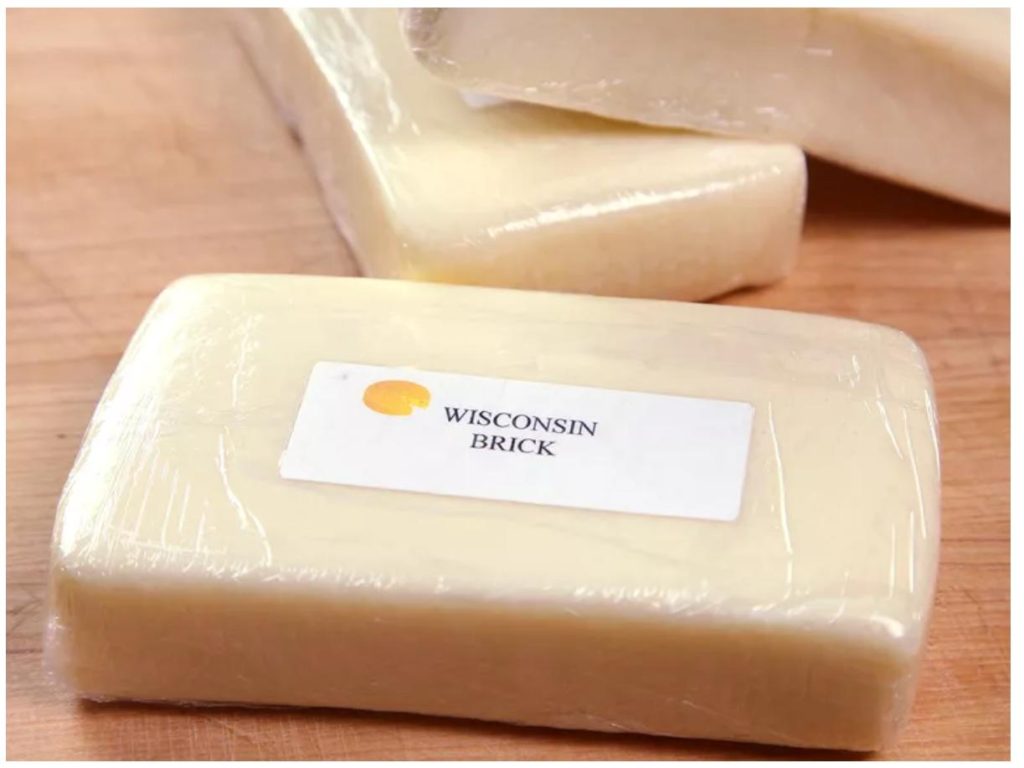
For my testing, I ordered a ton of Brick cheese from Amazon. If you order in bulk, it’s relatively inexpensive, and worth it if authenticity is what you’re after. (Don’t worry; I also found some viable alternatives sold in supermarkets.) When I visited Dave Lichterman, the man behind Windy City Pie, in his Seattle kitchen a few months ago, he showed me how he makes his cheese crust. He starts by filling out a pan with dough, then lays overlapping slices of cheese (not grated cheese!) on top, letting each one ride off the edge of the pan to line the sides, where they crisp and bake into shape.
I tried that method with my Detroit-style pizza, but the problem was slicing the Brick cheese—it’s very soft, which makes slicing an almost impossible endeavor. Just for kicks, I tried using presliced supermarket cheeses of various flavors. None of them seemed to crisp up the way Dave’s does.
I wondered if the shape of the cheese wasn’t the only issue. Up until now, I’d been cooking my pizza in standard aluminum rimmed baking sheets. Maybe there is some truth to what people say about those special Detroit pans being the secret ingredient in Detroit pizza?
The classic Detroit pizza pan is a deep, 10- by 14-inch rectangle of metal with black surfaces (for better conduction) and sides that flare gently away from the bottom. While the original pans were made from blue steel, most modern pans are made from anodized aluminum and come with a nonstick coating. I tested a number of these pans and found that yes, the black surfaces really did make a difference in how well that cheese crisped.
The best one I tried was from LloydPans. They’ve been making these pans since the ’80s. This is a specialty item for sure, but once you try this recipe, I can guarantee that you’ll be using it with regularity. Still, if you don’t want a dedicated pizza pan, I found that you can get decent results from a pair of deep, well-seasoned or nonstick 8- by 8-inch cake pans.****
**** The crust doesn’t come out quite as nice when you use a pair of cake pans, but you do end up with more of it because of the two extra edges, so it’s a pretty fair trade.

After stretching my dough, I added a layer of diced Brick cheese, which I made sure to spread all the way to the very edges of the pan. Buddy’s in Detroit claims that it uses a full pound of cheese for each pizza. I’ve seen some recipes that call for eight ounces or less. I ended up splitting the difference by adding 12 ounces of diced cheese. Don’t get me wrong: It’s still a ton***** of cheese, but not so much that eating it becomes painful.
***** Not literally a ton.
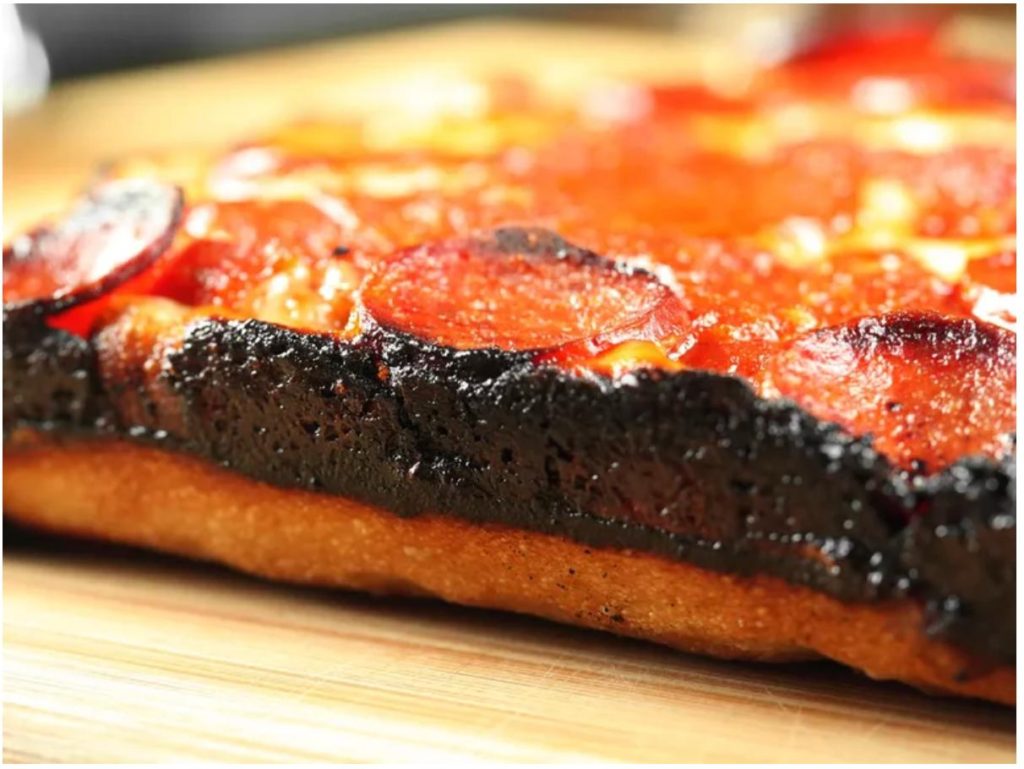
Ya see how nice that cheese-and-pan combo works out? For the record, the cheese crust may look black, but I can assure you that it does not taste burnt or bitter. I can’t explain it. In the wise words of Oscar Gamble, they don’t think it be like it is, but it do.
Swapping out that Brick cheese for a different cheese turned out to be surprisingly difficult. Not only does Brick cheese have its own flavor, it’s also extremely high in fat, which is important. As that butterfat drips down into the pan, it fries directly into the crust. Many people note that Detroit pizza has a buttery flavor despite containing no butter at all; that flavor comes from the Brick cheese fat.
At Tony’s Pizza Napoletana in San Francisco, owner and pizza savant Tony Gemignani uses cheddar around the edges. The cheddar comes out reasonably lacy and crisp, but the flavor reminds me more of a crisp-edged grilled cheese. I tried sliced and cubed low-moisture mozzarella and young, soft Jacks. I even gave Havarti a go. In the end, the closest substitute I could find was a 50/50 mix of low-moisture mozzarella (which provides some of that clean, buttery dairy flavor) and Jack (which has plenty of fat and also tanginess).
Cheese and Pan Combinations
With the dough out of the way, I turned my attention to the cheese. Detroit pizza is unusual in two ways when it comes to cheese. The first is the use of Brick cheese, a high-fat aged cheese from Wisconsin with a uniquely tangy, salty, buttery flavor that’s hard to replace with alternatives. The second is the edges. If you’ve ever been to Pequod’s or Burt’s Place in Chicago, or, better yet, had a pizza from Windy City Pie in Seattle (incidentally, the best Chicago-style pan pizza I’ve ever had anywhere, including in Chicago), then you’re familiar with the concept of a crispy, blackened cheese crust—the shelf of crisp, lacy cheese that surrounds the edge of the pizza. This is where the real magic of Detroit-style pizza lies, and, as I found out, getting it is not exactly straightforward.

Like tuning into a Bill Nye marathon when you’re in the mood for Mr. Wizard, it’s not quite the same, but it’ll leave you mostly satisfied.
Seasoning the Sauce
Compared to the struggles I went through to nail the crust and cheese, the sauce was a piece of cake. Unlike a typically sparse Neapolitan- or New York–style pizza sauce, Detroit-style pizza sauces are usually heavily seasoned with aromatics. To make mine, I started by sautéing fresh garlic, a little pinch of pepper flakes, and a good amount of dried oregano in extra-virgin olive oil before adding tomatoes. I generally recommend using whole peeled tomatoes that you crush yourself by hand, as whole peeled tomatoes exhibit more consistency than other types of processed tomatoes. But in this case, without a food mill, it’s hard to get the uniform crushed texture that you want in Detroit-style pizza sauce, so I opted for canned crushed tomatoes instead.****** So long as you use a good-quality brand, like Muir Glen, Bianco DiNapoli, or Cento D.O.P. San Marzanos, crushed will do just fine.
****** Little CA-living brag here: The very best sauce I made was from the San Marzanos I grew and canned myself last summer. Thpbhbpbhpbphpbtbh.
Some recipes call for canned pizza sauce or tomato paste. I find that both can dull flavor too much, so I prefer to simmer down my tomatoes until they’re nicely reduced and intensely flavored.
My sauce was tasty, but it was still missing something. I’m generally a “fresh garlic all the way” type of guy, but I couldn’t shake the feeling that granulated garlic powder might be that missing element. Turns out I was right.
Adding a small dash of granulated garlic and granulated onion, along with a bit of sugar, was the key. Now, I know from experience how uncomfortable people can get about sugar in their tomato sauce, so I’ll tell you right now: I don’t care. If putting sugar in tomato sauce offends you, by all means, keep it sugar-free. I promise I won’t stop you. Meanwhile, I’ll be over here, eating my delicious pizza, and no, you can’t have any.
There’s a school of thought that suggests waiting to add sauce to a Detroit pizza until after it comes out of the oven. That’s not a bad way to do it, but I prefer the cosmic oneness that the pizza achieves when the cheese and sauce are cooked together.
Toppings and Baking
The only thing left to address is how to add toppings and bake this thing. You can feel free to use whatever toppings you personally like, but to my mind, pepperoni is the only real choice here.

I mentioned before that some restaurants like to place the pepperoni under the cheese, while others place it on top. I really do like the way the flavor gets integrated into the dough when you place the pepperoni underneath, but giving up those crisp, charred edges from pepperoni cooked on top of the pie physically pains me, so I thought: Por que no los dos?

Laying pepperoni out under and over the pie gives you the best of both worlds. Incidentally, make sure to use a high-quality natural-casing pepperoni, like Vermont Smoke & Cure, or even Boar’s Head (the stick version, not the presliced!). That’s how you guarantee that your pepperoni will cup up into those crispy little grease chalices that Adam Kuban is so fond of.*******
******* You can read up a bit on the fascinating science of what makes pepperoni curl right here.
The only thing left to test was baking, and, unfortunately, here’s where things get a wee bit hairy. The problem is that ovens are not very accurate, or even uniform. Most ovens tend to heat more from the bottom than from the top, but some are the opposite. Some ovens maintain a steady temperature, while others fluctuate wildly up and down.
I have a few pieces of advice here. First, set the oven as hot as it will get. In a home oven, that’s 500 to 550°F (260 to 290°C). At those temperatures, you get good browning and crisping of the crust before the dough has a chance to dry out too much. But even then, you might find that the top of your pizza ends up cooking before the bottom does. If you know that your oven doesn’t heat much from the bottom, or if you make the recipe and find the base is not quite as crisp as you like, you have a couple options.
First is to place the pan on top of a preheated Baking Steel, which will help pump heat into the base of the pizza, where it’s needed most. Your second option is to place the pizza directly on the floor of a preheated oven, which will also give it a nice, quick energy boost.

n a hot oven, the pizza cooks in about 12 to 15 minutes. You’ll know it’s done when the cheese around the edges is sizzling and black and the top is very lightly browned.

Once it comes out of the oven, use a thin metal spatula to carefully prise the edges away from the pan, giving the whole thing a few shakes until it seems to move around freely.
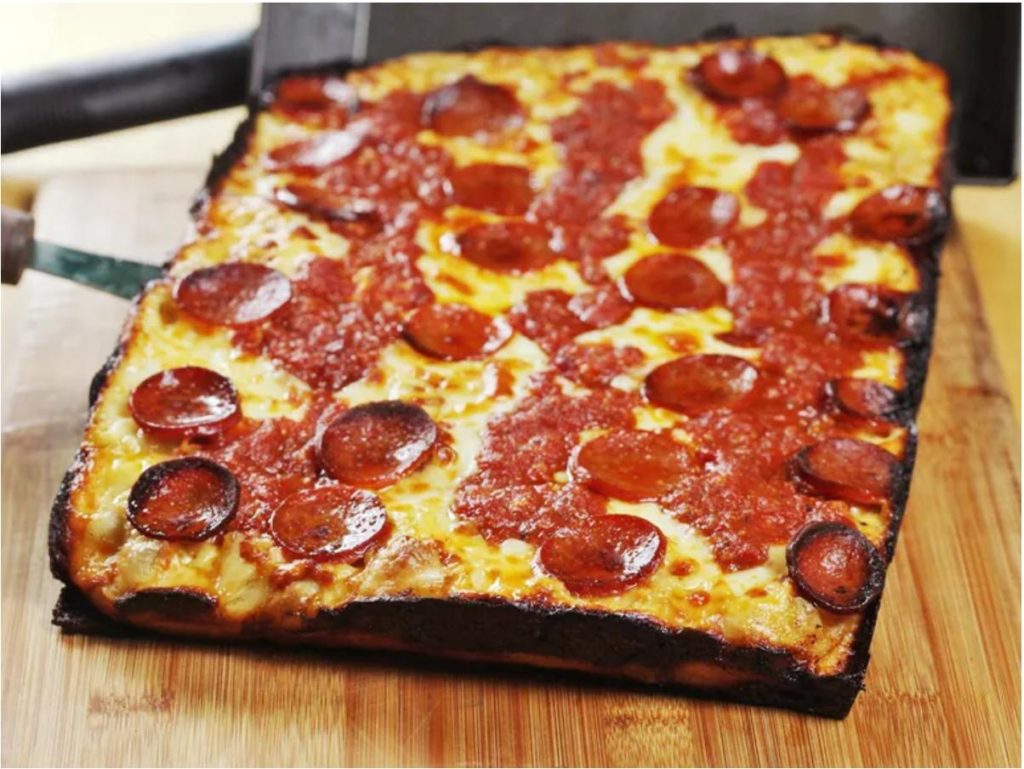
From there, transfer the pizza to a cutting board, and do your best not to immediately plant your face in it. That’s rude. And also liable to give you severe burns on your eyeballs. That’s something nobody likes.
You know what’s something that everybody likes? Delicious pizza. Like the one you’re going to make this week.
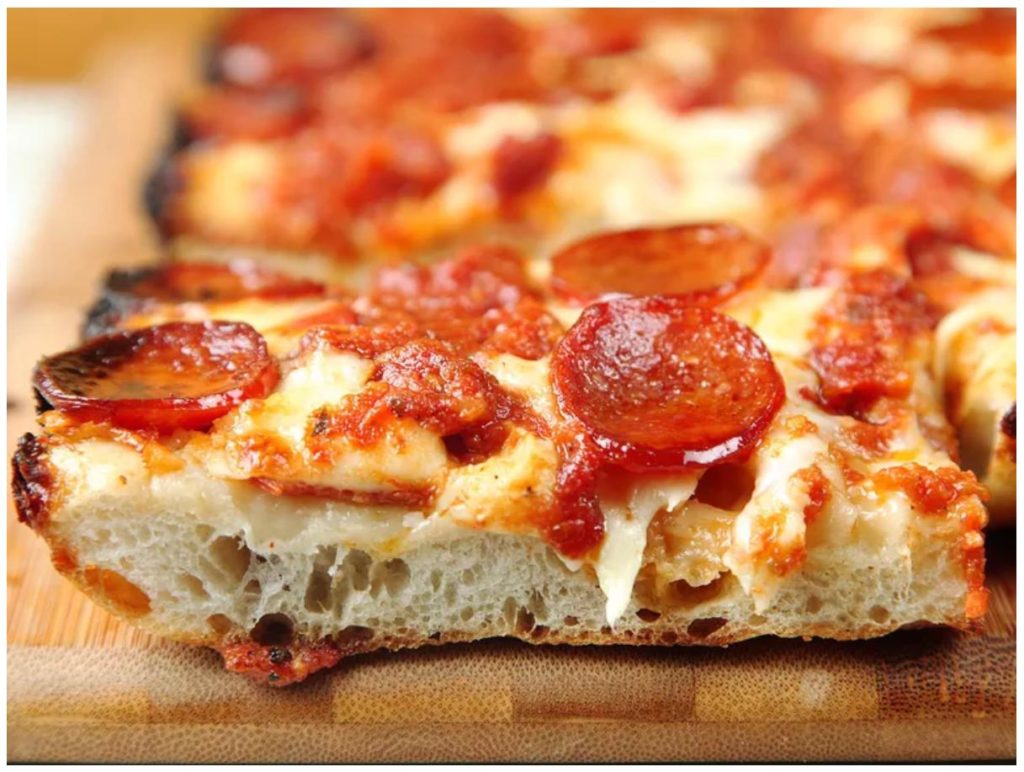
I mean, just look at that crumb. Oh, oh! And let me show you the best part:
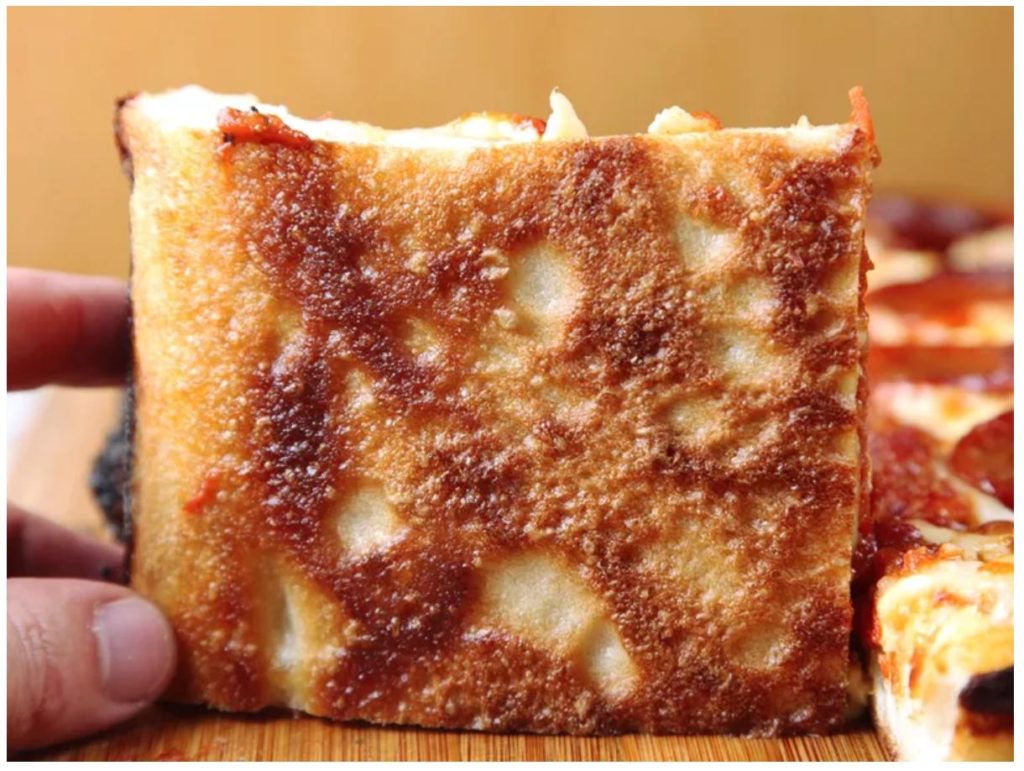
Now that? That’s the stuff that dreams are made of. Welcome to Detroit, my friends.
Ingredients
For the Dough:
- 300g bread flour (10.5 ounces; about 2 generous cups)
- 5g instant yeast (0.15 ounce; about 1 teaspoon), such as SAF Instant Yeast
- 9g salt (0.3 ounce; about 1 1/2 teaspoons table salt or 1 tablespoon Diamond Crystal kosher salt)
- 220g water (7.75 ounces; about 1 cup minus 1 1/2 teaspoons)
- Extra-virgin olive oil, as needed
For the Sauce:
- 2 tablespoons (30ml) extra-virgin olive oil
- 3 medium cloves garlic, minced
- 2 teaspoons (about 5g) dried oregano
- Dash red pepper flakes
- 1 (28-ounce; 800g) can high-quality crushed tomatoes
- 1 teaspoon (about 6g) granulated garlic powder
- 1 teaspoon (about 6g) granulated onion powder
- 1 tablespoon (about 15g) sugar
- Kosher salt, to taste
To Finish:
- 12 ounces (340g) Brick cheese, cut into 1/2-inch cubes (see notes)
- 12 ounces (340g) high-quality natural-casing pepperoni, such as Boar’s Head or Vermont Smoke & Cure, cut into 1/8-inch slices (optional)
Directions
-
To Make the Dough in a Stand Mixer: Combine flour, yeast, and salt in the bowl of a stand mixer fitted with a dough hook attachment. Stir to combine, then add water. Mix on low speed until dough comes together into a rough ball, then shut off mixer and let rest for 10 minutes. Continue mixing at medium-low speed until dough forms a smooth, silky ball, about 10 minutes longer. (It should stick to the bottom of the bowl as it kneads rather than riding around the edges.) Remove dough hook, form dough into a tight ball, set in the bottom of the mixer bowl, cover tightly with plastic wrap, and set aside in a warm place until dough has roughly doubled in volume, about 2 hours.

-
To Make the Dough in a Food Processor: Combine flour, yeast, and salt in the bowl of a food processor and pulse to combine. Add water, then turn on processor and process until dough forms a ball that rides around the bowl of the processor, about 30 seconds. Continue processing for 30 seconds longer. Transfer dough to a bowl, form a tight ball, cover tightly with plastic wrap, and set aside in a warm place until dough has roughly doubled in volume, about 2 hours.
-
To Make the Dough by Hand: Combine flour, yeast, and salt in a large bowl. Whisk to combine, then add water and stir with a wooden spoon until a rough ball of dough has formed. Set aside for 10 minutes. Turn dough out onto a countertop and knead until a smooth, silky ball has formed, about 10 minutes. Transfer dough to a bowl, form a tight ball, cover tightly with plastic wrap, and set aside in a warm place until dough has roughly doubled in volume, about 2 hours.
-
Pour a couple tablespoons olive oil in the bottom of a Detroit-style anodized aluminum pan or two 8- by 8-inch cake pans. (Split dough in half if using cake pans.) Transfer dough to pan(s) and turn to coat in oil. Press down on dough and spread it toward the edges. You won’t be able to get it all the way to the edges; this is okay. Spread it as much as you can without tearing, then cover tightly in plastic and set aside for 30 minutes to allow dough to relax. Return to dough and stretch it out again. It should be able to reach the edges this time. If not, let it rest a little more and try again. To get the dough to stay in the corners, stretch it up beyond the corners so that it pulls back into place. Once dough is stretched, cover again and set aside while you make the sauce.

For the Sauce: Adjust oven rack to lowest position and preheat oven to 550°F (290°C), or as close to it as your oven gets. Heat 2 tablespoons (30ml) olive oil in a medium saucepan over medium heat until shimmering. Add minced garlic, oregano, and pepper flakes and cook, stirring, until fragrant, about 30 seconds. Add tomatoes, garlic powder, onion powder, and sugar. Bring to a simmer and cook until reduced to about 3 cups, about 30 minutes. Season to taste with salt.
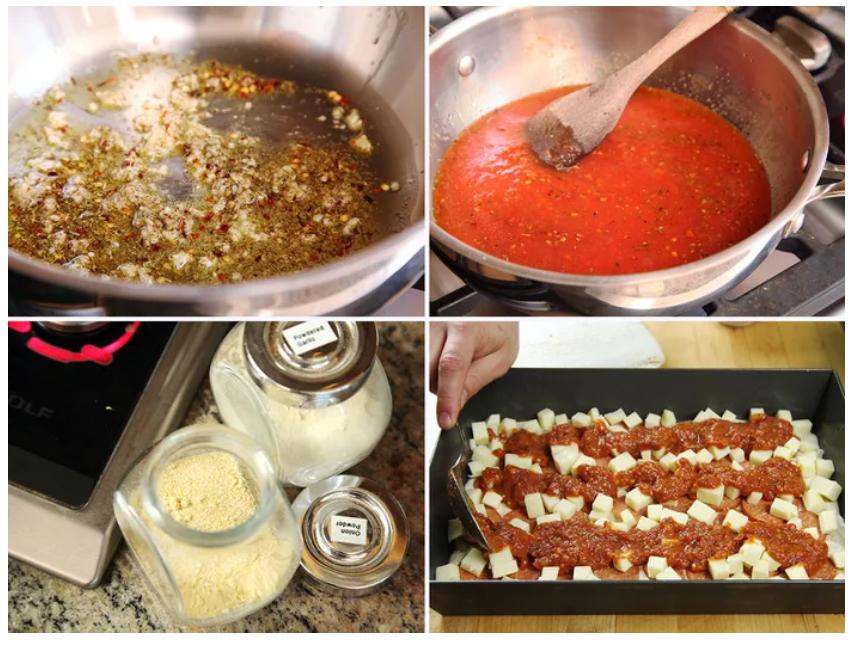
To Form the Pizza: Press down on dough with your fingertips to remove any large air bubbles. Lay half of pepperoni (if using) evenly over face of dough. Top with cheese, spreading it evenly all the way to the very edges of the pan, then add remaining pepperoni. Spoon sauce over surface in 3 even rows. (You will need only about half the sauce—save the rest for another pizza.)
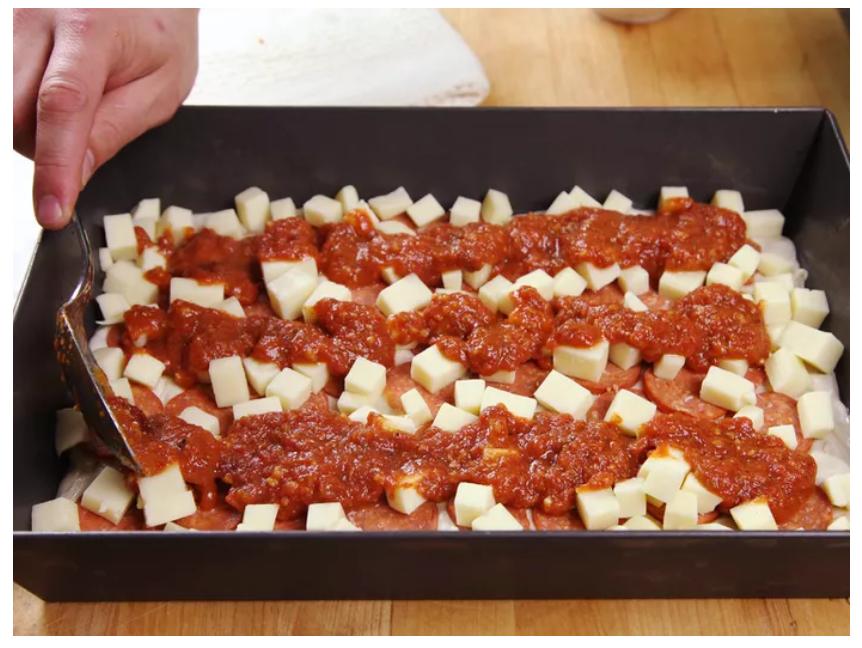
Transfer to oven and bake until edges are black and bubbly and exposed cheese on top is starting to lightly brown, 12 to 15 minutes. Transfer to a trivet or folded kitchen towel on countertop.
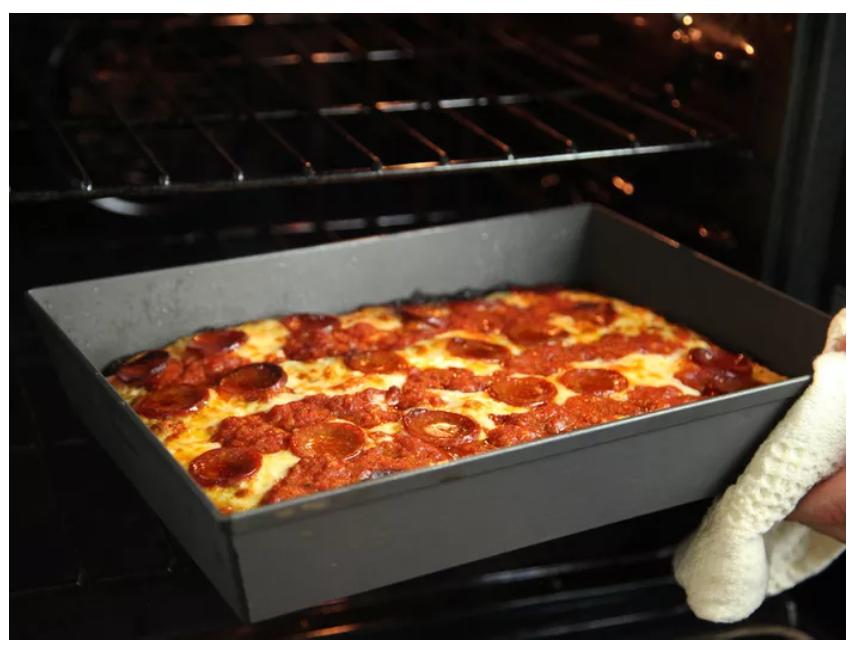
Run a thin metal spatula all the way around the edges of the pan to loosen the pizza. Carefully lift it out and slide it onto a cutting board. Cut pizza and serve.

Special Equipment
Stand mixer or food processor (optional), Detroit-style 10- by 14-inch anodized aluminum pan (see note)
Notes
Brick cheese is a high-fat aged cheese from Wisconsin. It has a buttery flavor and browns very well, giving Detroit pizza its distinct flavor. You can order it online from Amazon. If it’s unavailable, you can use a combination of Jack or young cheddar and low-moisture mozzarella.
For best results, use a Detroit-style anodized aluminum pan. If you can’t get your hands on that kind of pan, you can split the recipe into two square 8- by 8-inch cake pans.
Obama said “the planet can’t sustain 1.4 billion Chinese having the same living standard as Americans”, do most Americans agree with him?
The Americans are among the most wasteful people on the planet. So, yes, if 1.4 billion Chinese were as wasteful as the Americans, then our world would be fucked.
The Americans need to be a lot less wasteful.
Obama would’ve been right about the 1.3 billion Indians, too. And the collective population of around 1.3 billion in Indonesia, Pakistan, Nigeria, Brazil, Bangladesh, Russia, and Mexico. Are you suggesting that all of these nations mustn’t develop because they would drain our planet’s resources?
ALL nations have the right to develop. ALL nations must cooperate to develop as efficiently as possible for the benefit of all.
Do you consider the Japanese cuisine the most refined cuisine in Asia? If not, why?
I’ve worked in two high-end Chinese restaurants, both serving authentic Cantonese cuisine and more than eight different smaller authentic Chinese dim sum restaurants. (so authentic that our wait-staff were often described as curt and brusque).
I’ve also worked in two Korean restaurants, one a warm, cosy, family-style affair that specialized in samgyeopsal, and one a smaller affair inside a food court that served the usual varieties of bibimbap and guksu dishes.
Also, I’ve worked in one Japanese izakaya establishment specializing in more eclectic stuff – think uni omelette and motsunabe, two dishes Western folks might not find at their local sushi bar. And for one week, I had a wonderful opportunity to work with some very fine folks at a ryokan in the onsen town Yamashiro, in Ishikawa, preparing kaiseki-ryori. Well, they prepared it, I mostly listened, attempted, documented and wrote about it 🙂
Here’s a tofu dish I prepared that I (somehow) managed not to bungle:
(I actually do own this picture 🙂 )
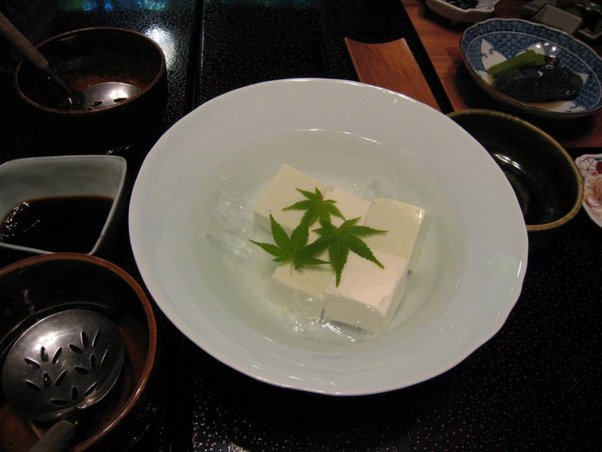
“Do you consider the Japanese cuisine the most refined cuisine in Asia? If not, why?”
From my living and moving from country to country, I’ve come to the conclusion that many Westerners (and by that I mean white folks from Australia, the UK, Ireland, the States, Canada, and Western Europe) consider Japanese cuisine the most refined of all Asian cuisines.
After all, in terms of aesthetics and plating, it mirrors the precision and beauty of French haute cuisine. That is the type of food that wins Michelin stars and haughty food critics rave about. It’s definitely no surprise to me that Japan is the Asian country that has the most Michelin 3-star restaurants (the second is Hong Kong by the way…) Forget Asian country – Japan is THE country with the most Michelin 3-star restaurants, in the world.
To people who salivate at eating at such restaurants, refinement means 3-stars. And Japanese cuisine ranks very high on that list, perhaps at their personal top spot.
To such people, “Refinement” in cuisine is equated to Michelin stars, aesthetics, and clean flavors.
Such people often consider all other Asian cuisine unrefined.
As an Asian, I’ve heard the below reasoning too many times:
“ Asian cuisines (non-Japanese) use spices to cover up the inferior quality of their ingredients. You would only use spice if you had inferior quality ingredients.”
Look no further than to one of the answers here, written by one Angel Lopez.
I have found this reasoning to be popular in white-dominant countries.
You can see it on Quora as well. I’ve lost count of the number of people here who think European cooking is superior to Asian cooking because – get this – Asian cuisines uses “spices” to “cover up” “inferior/bad quality ingredients”.
I’ve heard it all:
- Chinese cuisine is too sweet, too greasy.
- Korean cuisine is too spicy.
- Thai cuisine is too spicy.
- Indian cuisine is too spicy.
- Filipino cuisine is too messy and simple.
- Singaporean / Malaysian / Indonesian cuisine is too spicy
- Asian cuisine doesn’t have fresh foods! (this is the most bizarre one yet)
I think Vietnamese cuisine may be the only Asian cuisine I’m familiar with that tends to escape such criticism.
And Vietnamese cuisine is influenced by French cuisine…. so…. well….
Many of the people who come up with the above criticisms (not all, but I would posit many) have never even been to the above mentioned countries and base their opinions on the localized versions of the cuisines they get in their own country.
For example, saying “Chinese cuisine is terrible” based on their experience eating at Panda Express or a Chinese restaurant in the middle of nowhere that serves Teriyaki chicken opposite Beef and Broccoli.
“Yes, Dante, but do YOU consider the Japanese cuisine the most refined cuisine in Asia? “
If by “refinement”, you’re talking about cuisine that can win Michelin stars, that focus on visual aesthetics in plating and in presentation, that focus on clean tastes – then yes, I would say that Japanese cuisine could be considered the most refined cuisine in Asia.
But, unlike those who find the spices found in Asian cuisines off-putting and base that opinion on the very erroneous presumption that people only use spices when the ingredients are inferior or bad, I find great joy in eating Asian cuisines of all kind.
I’ve never considered non-Japanese Asian cuisine to be, in any way, shape, or form inferior to European cuisines.
The food in Asia is super fresh – sometimes, the chicken/fish etc has just been slaughtered minutes prior to your meal – and tasty to boot.
Why settle on one Asian cuisine when you can have more than handful of ‘em?
Why settle for one flavor palette when you can have an explosion of different flavors and textures?
My Delores
A woman writes about her cat. -MM

I had spent over an hour looking at all the kitties at the shelter. I finally picked one out, and the lady was getting the paper work. While she was gone, the cat out of nowhere hissed & struck out at me.
I took it as a sign.
I didn’t want to start off that way.
There were lots of kitties. I sat there talking with the shelter lady, and one kitty I hadn’t noticed came over and gently crawled up into my lap.
She was so sweet. She’d probably been hiding a bit, watching me. The ladies there loved her.
Her name was Delores. A beautiful Calico/ tortie looking kitty. And she had claimed me.
She started purring away.
I put her aside and she came right back. It was destiny.
She came home with me.
She followed me everywhere.
We were best friends.
They told me at the shelter she was about 5, but later the vet said she was probably twice that.
I had her less than a year.
She died suddenly of kidney failure and I literally cried for three years. I loved her so much.
I can’t think about her at all without crying, even as I write this. There was just something very special about my Delores.
…
.



What should we bring back from the 40’s, the values of the greatest generation for a start. Love the Tofu pot roast LOL.
Kitties are fantastic, are they not?
You can easily hear my fat cat purring from 20 feet away – six or so meters for you metric folks. Loud rumbling engine – it’s wonderful.
Loved the Denzel clips.